For about half a year now, I’ve been going out almost every day to recapture old photos of Berlin as accurately as possible. I started doing this to better understand how the banality of everyday life continues despite historically extreme periods of time.
Many “anchors” in the city landscape like old houses and trees help to build a bridge to another time and to better relate to the people that lived in it. Finding the exact position, where another person took a photo many years ago has become a very rewarding passion of mine. I hope you enjoy the results as much as I do!
Most of the photos I’ve recaptured were taken by two photographers that did an amazing job documenting the city over many years: Chris John Dewitt and Jürgen Henschel.
More info: ReFilm.io
Linie C (1923/2019)
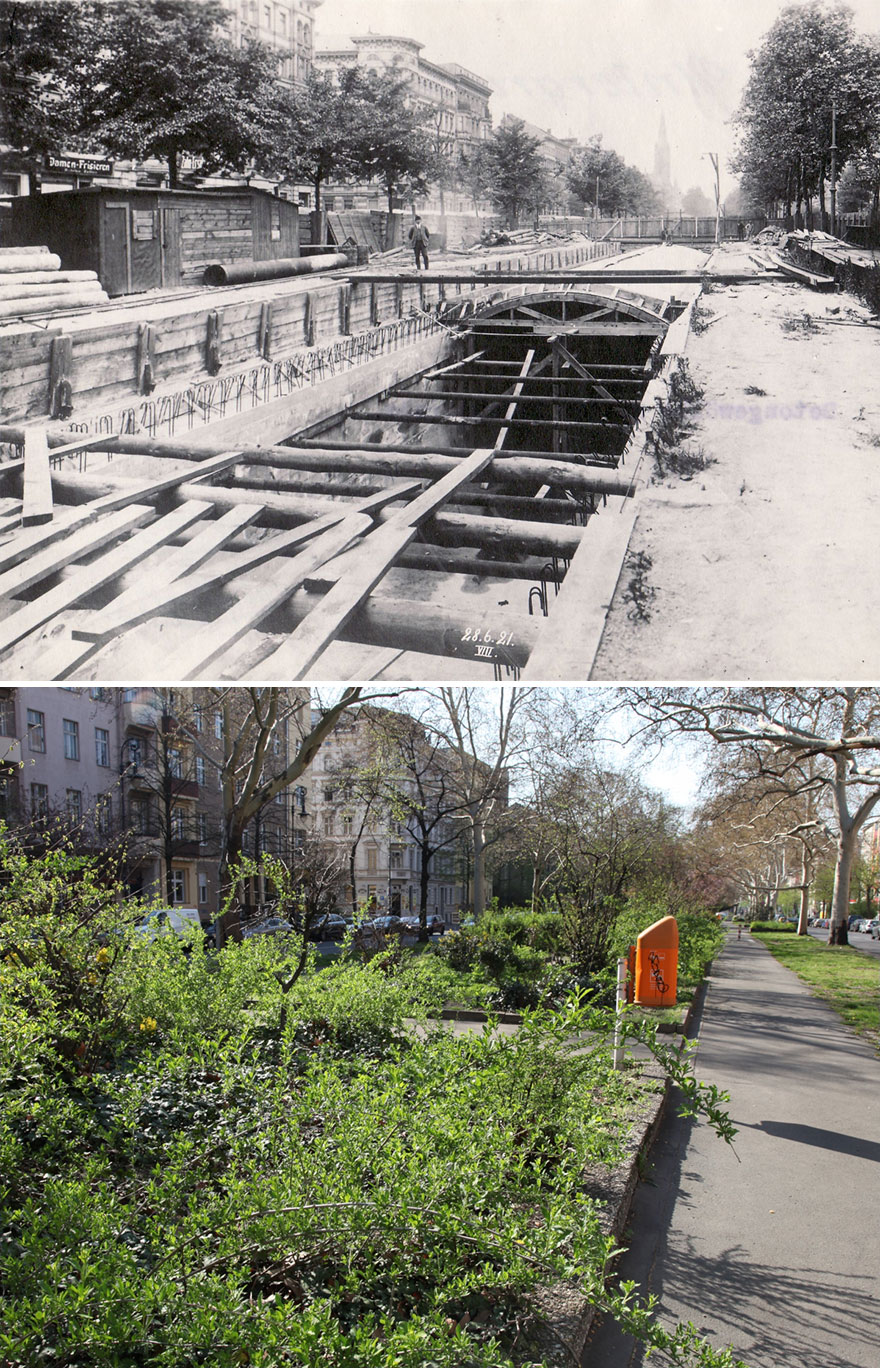
Image credits: refilm.io
This amazing photo shows the construction of the subway line “C” on Gneisenaustraß in Kreuzberg between Zossener Straße and Solmsstraße. Today the “U-Bahn” line is called “U7” and the location is only a few meters away from the station “U Gneisenaustraße”.
The two buildings in the center of the photo seem to not have changed much and one can still see the Pfarrei St. Bonifatius church through the trees.
Eldorado drag bar turned into organic shop (1932/2019)
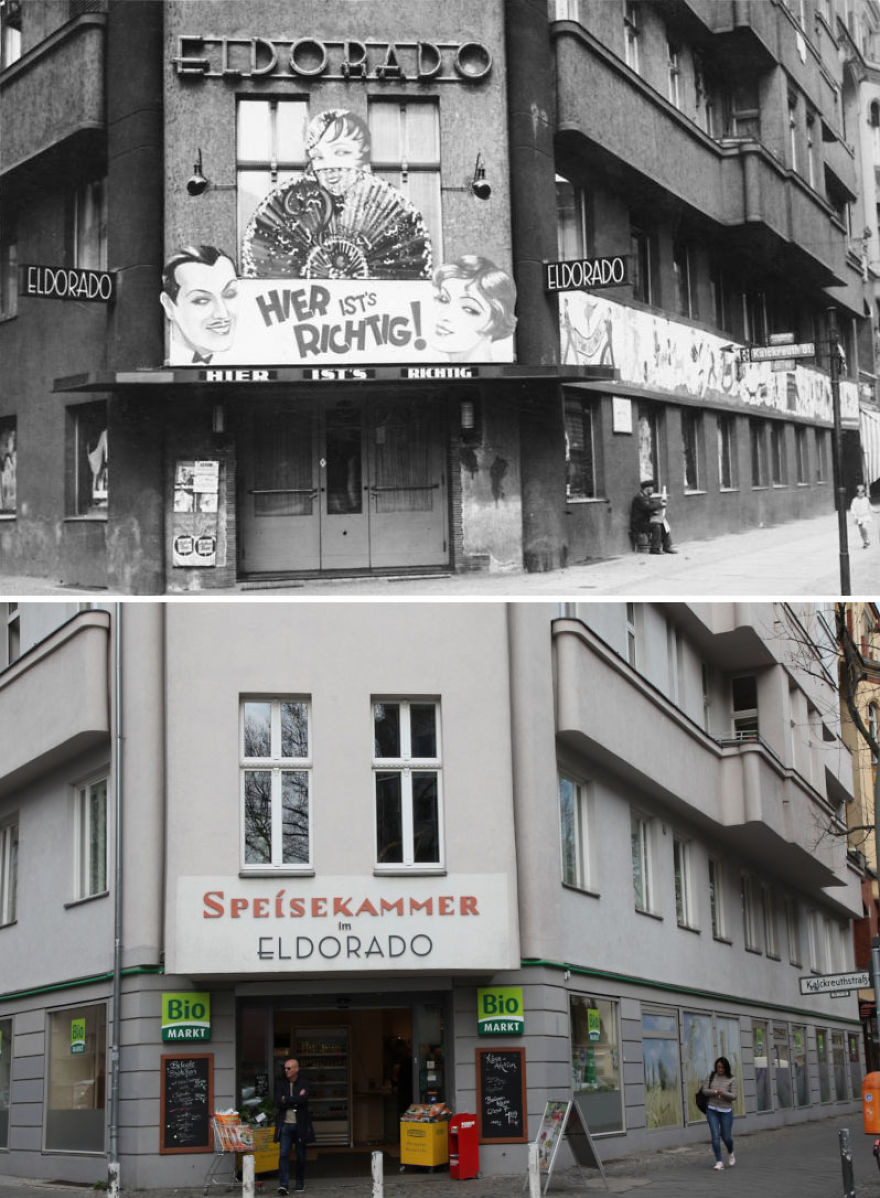
Image credits: refilm.io
For the last century, Motzstraße in Schöneberg has been considered to be a gay-friendly neighborhood. The author Christopher Isherwood lived just around the corner, where he was inspired to write many of his books, one of which was made into the movie “Cabaret” starring Liza Minnelli.
Altes Museum (1936/2019)
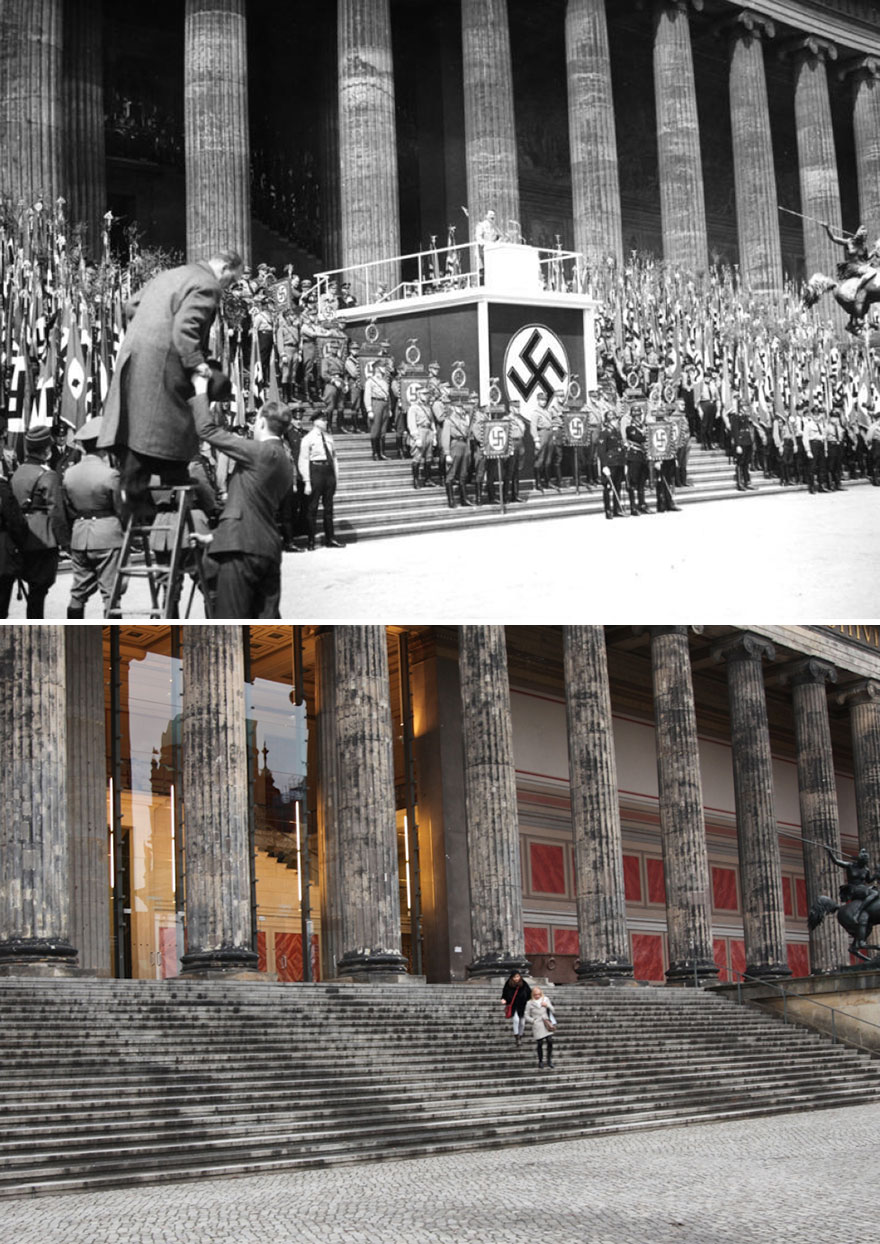
Image credits: refilm.io
The photo of 1936 shows Adolf Hitler delivering a speech on 1 May 1936. Labor Day was renamed to “National Holiday of the German People” by the Nazis. While a lot has changed since then, one can spot the same stains on the columns of “Altes Museum” in the photo of 2019, which makes me feel like this didn’t happen that long ago.
From a sociological perspective, the period between 1933 and 1945, when the Nazis were in power, is probably the hardest to grasp. More than with any other recreation I did, I was wondering about the emotions the photographer must have had, when he was standing in this exact same spot.
War damage in the 40s: Hermannplatz (1945/2018)
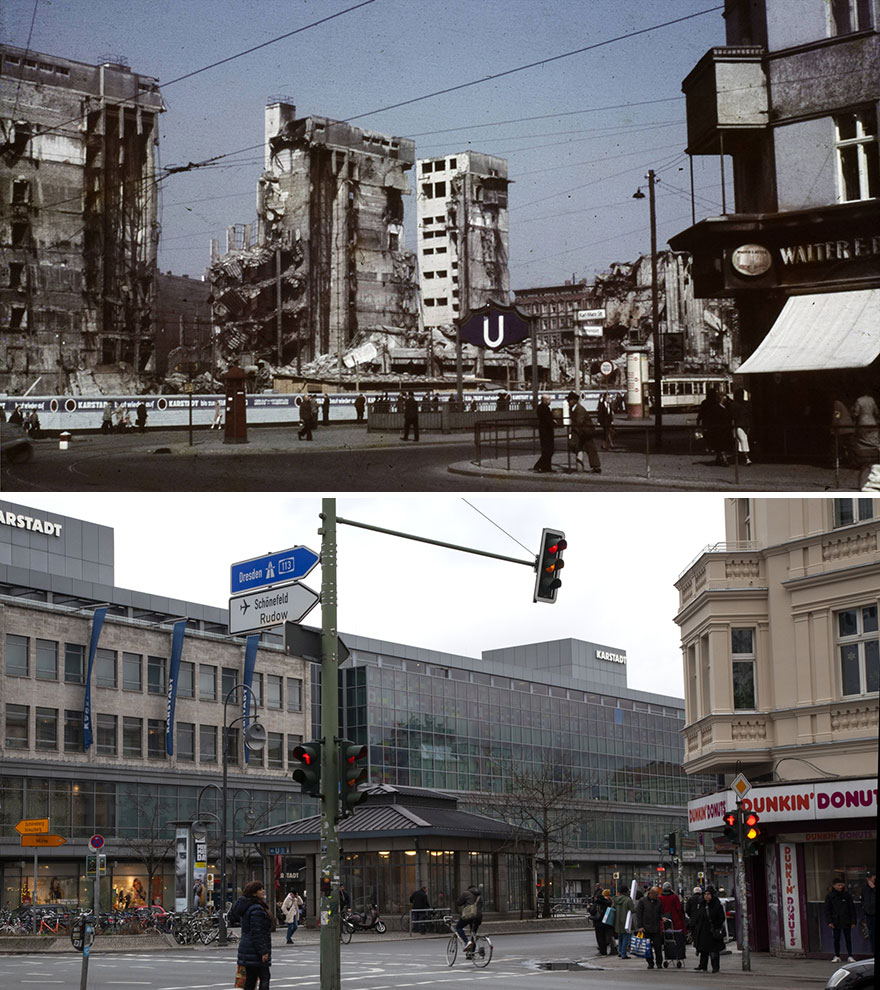
Image credits: refilm.io
The department store Karstadt was destroyed in the “Battle of Berlin” and later rebuilt in a much less impressive way.
The house in the foreground once built in the Gründerzeit style is the same to this day. However, at some point, it must have fallen victim to a restyling process called “Entstuckung” that was very common between 1920 and 1975 in Germany. At the time, the beautiful facades were considered too fake and were therefore plastered over.
For me, the most striking impression of the old photo is how relaxed the people in the streets seem to be. Living their everyday life in the aftermath of the destruction of their city. If anything, they seem more laid-back than the ones I met on the street the day I photographed this.
Forum Steglitz (1970/2019)
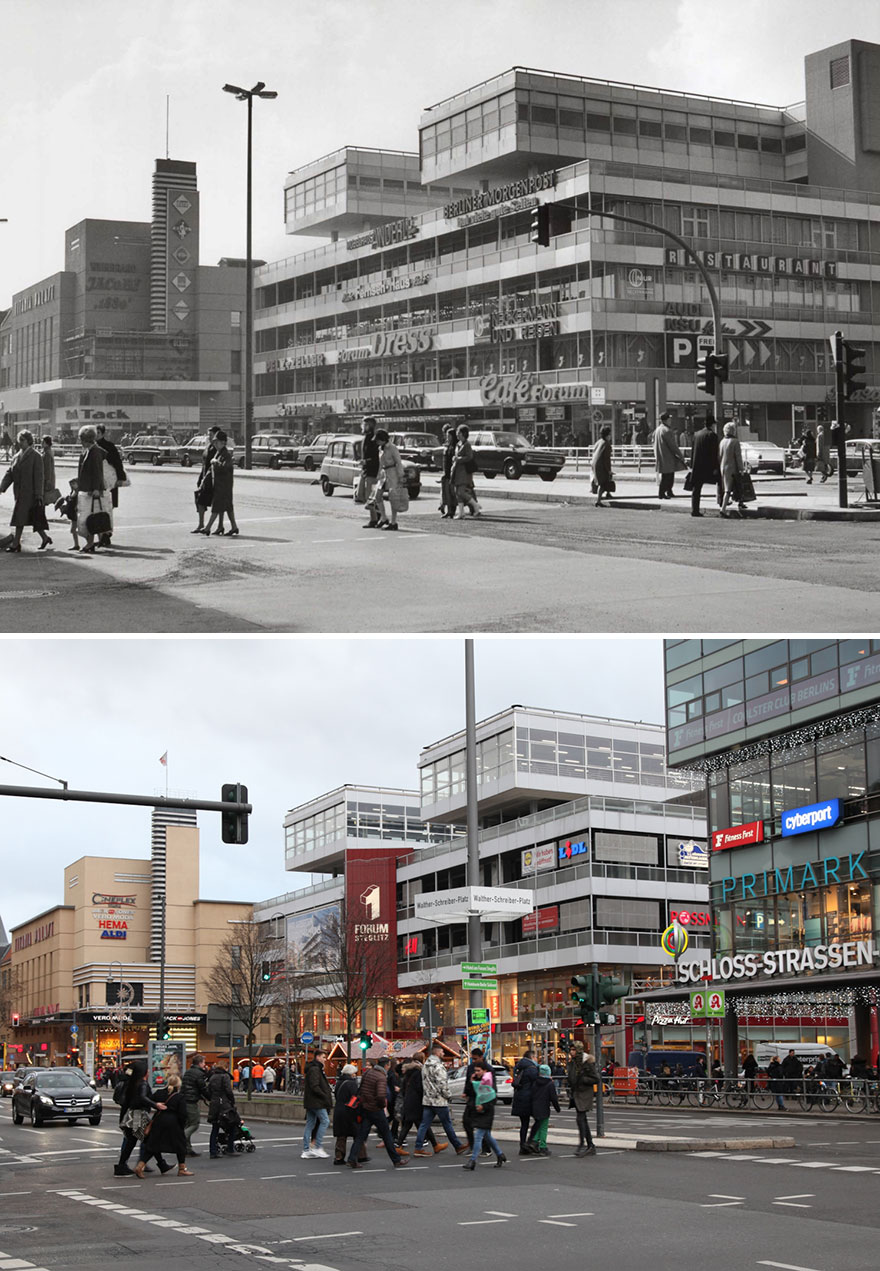
Image credits: refilm.io
The shopping mall Forum Steglitz in Schloßstraße opened in April 1970. It was one of the first shop-in-shop centers in Germany. Situated in West-Berlin until 1989, the upper floor of the building was home to a visa office run by the East German Stasi.
More than in any other of my recreations, I can see the connection of the people in those two photos. The cars, the shops and the style of clothing might have changed, but after all, the people walk this street with exactly the same plan – to go shopping!
Another generation of the Wall (1976/2018)
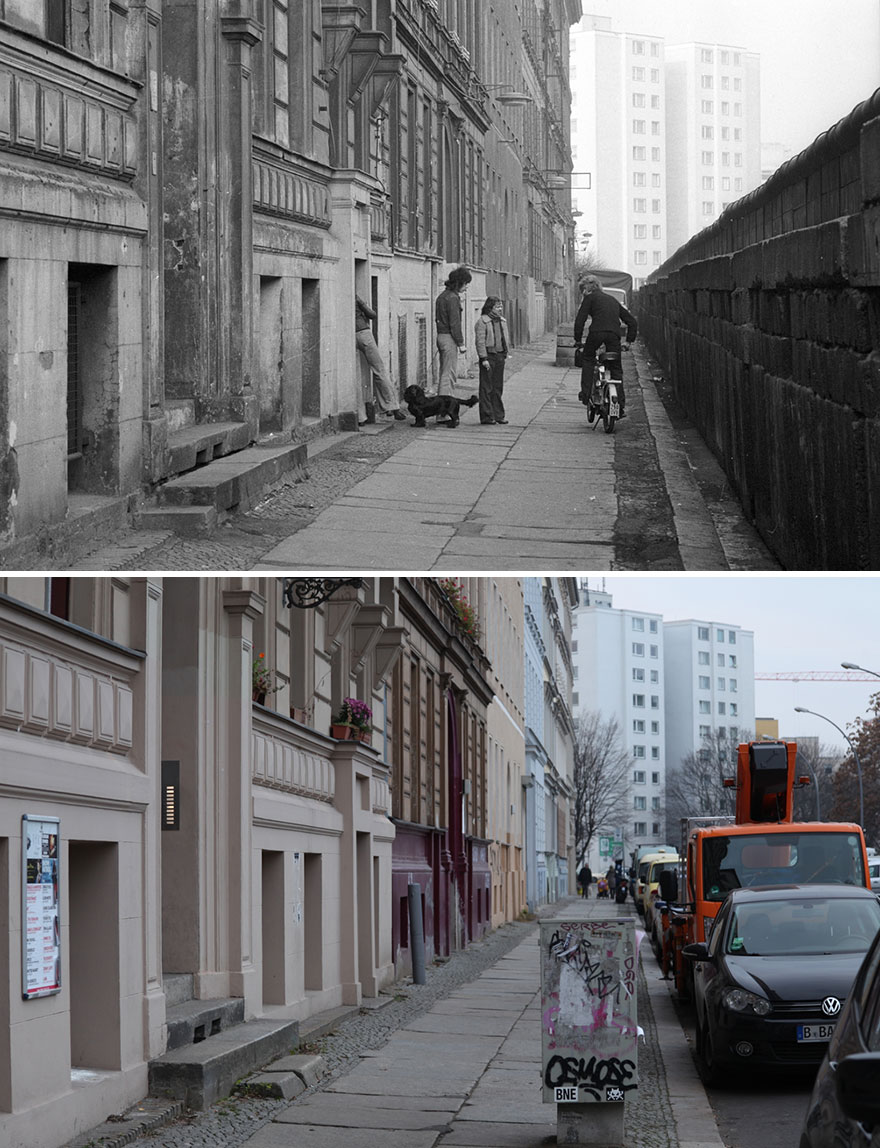
Image credits: refilm.io
Originally, the Berlin Wall did not look the way we all got used to seeing over time. It was reinforced over and over again. The photo shows an older generation of the Wall in Sebastianstraße, Kreuzberg.
Holsten-Eck (1976/2019)
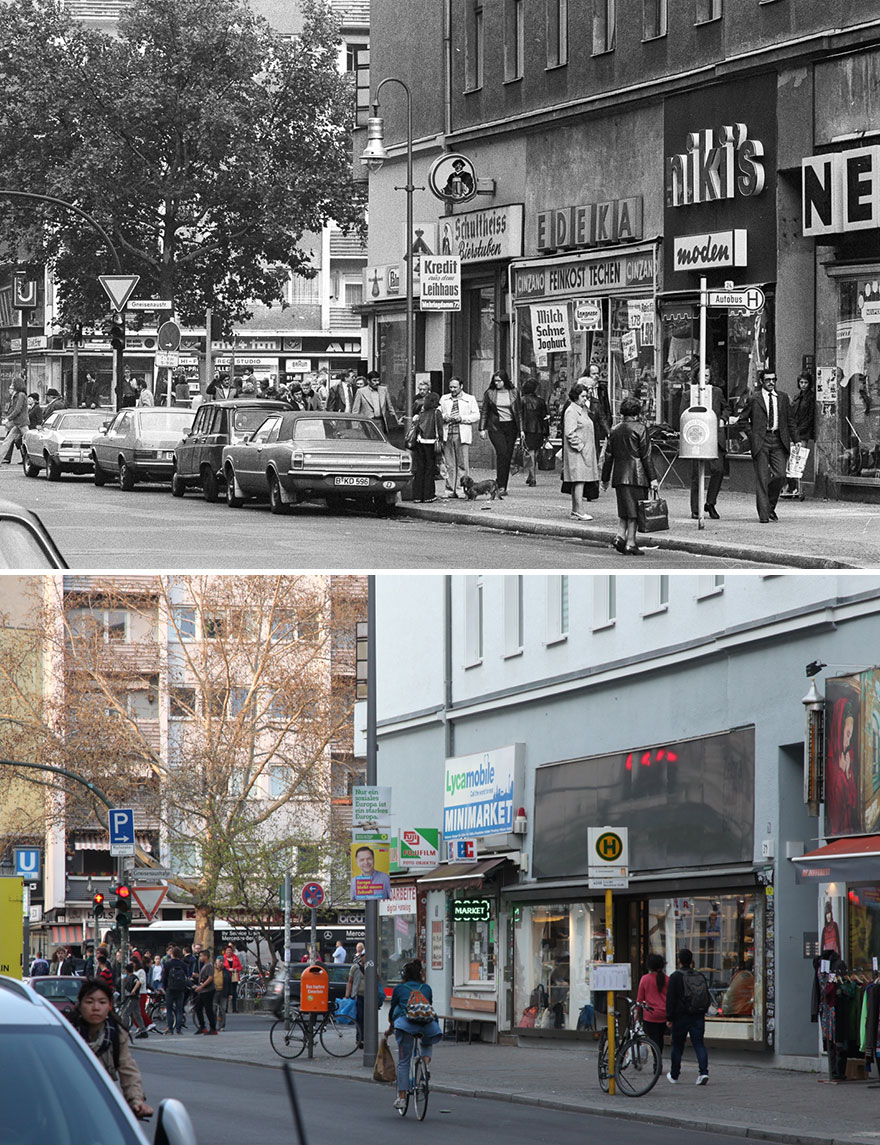
Image credits: refilm.io
This area around the intersection of Gneisenaustraß and Zossener Straße in Kreuzberg has changed considerably over the years. However, one institution hasn’t changed at all: the dive bar Holsten-Eck behind the yield sign is exactly where it was 43 years ago.
Walter-Rindfleisch-Gedächtnisrennen (1976/2018)
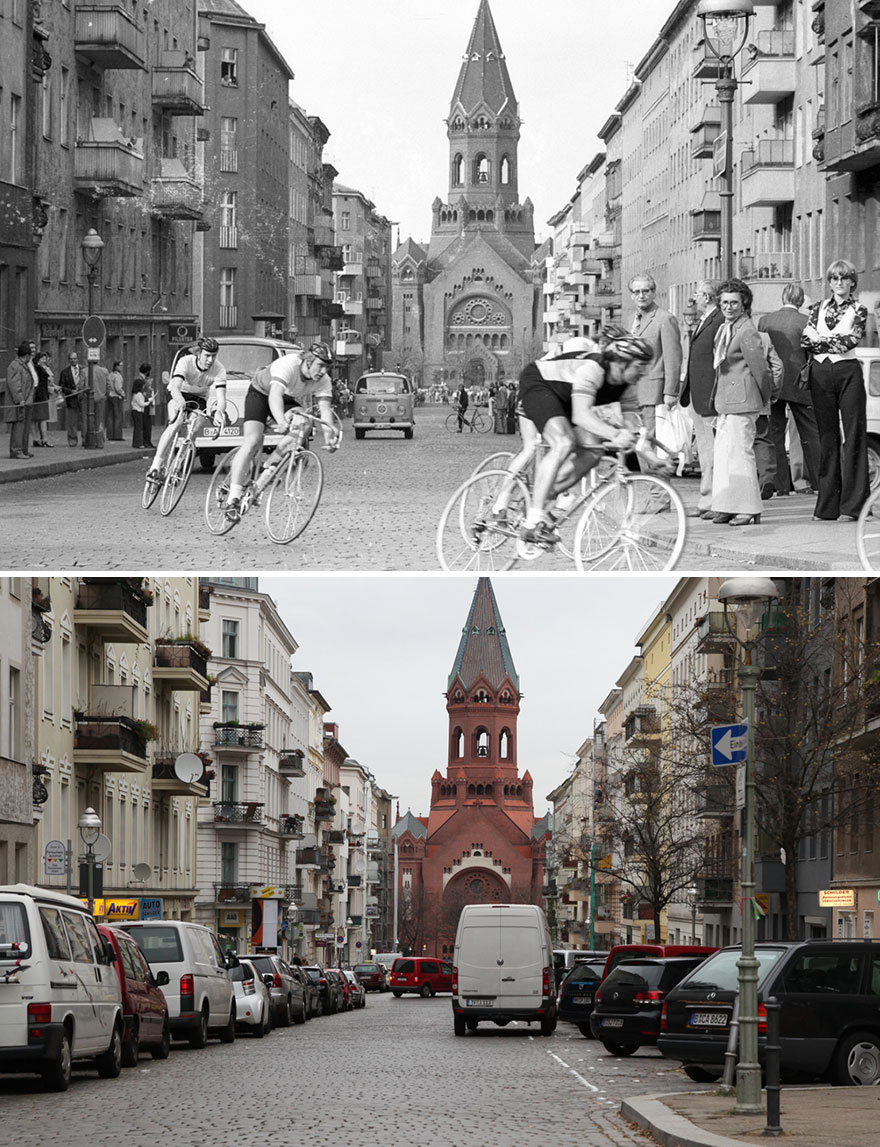
Image credits: refilm.io
Heimstraße, Berlin Kreuzberg.
Bio Markt (1977/2019)
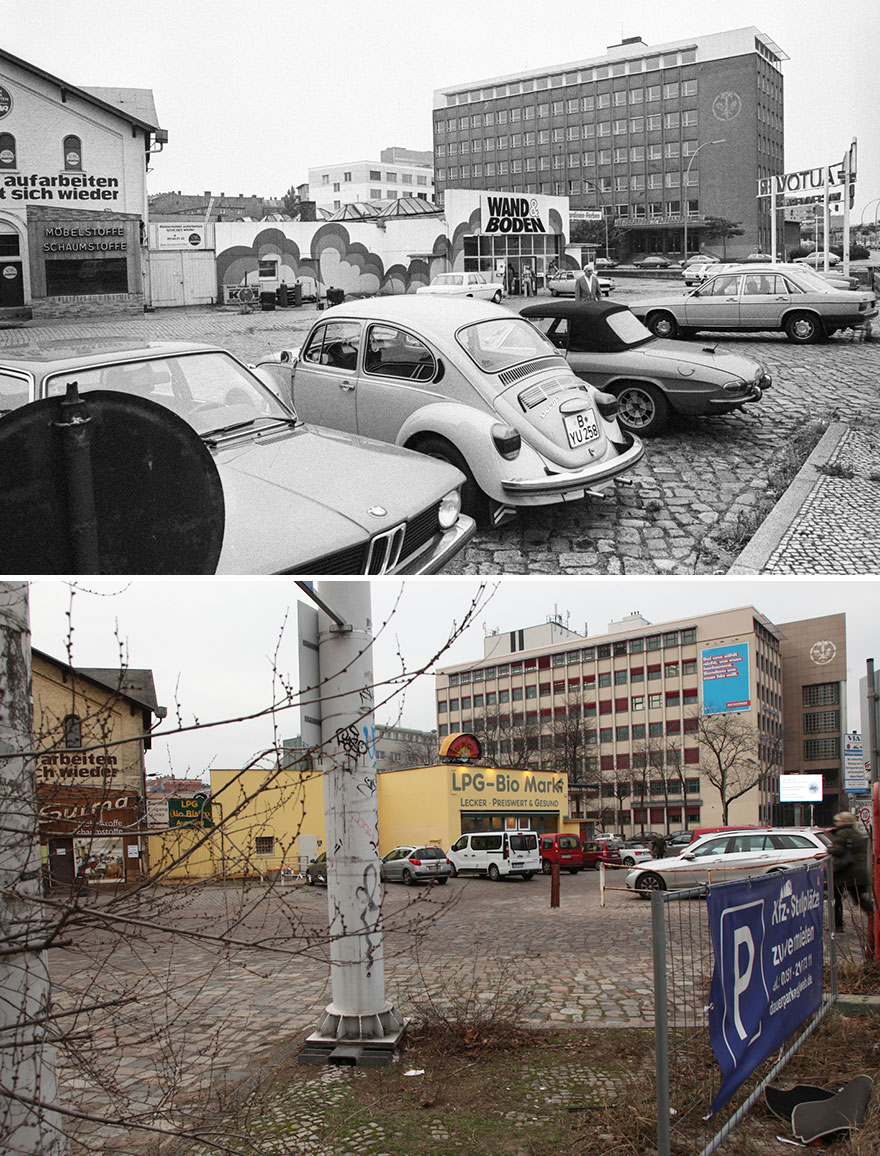
Every building seems to be transformed into an organic food store in Berlin Kreuzberg. The photos were taken on the corner of Mehringdamm and Obentrautstraße.
Reunification (1979/2018)
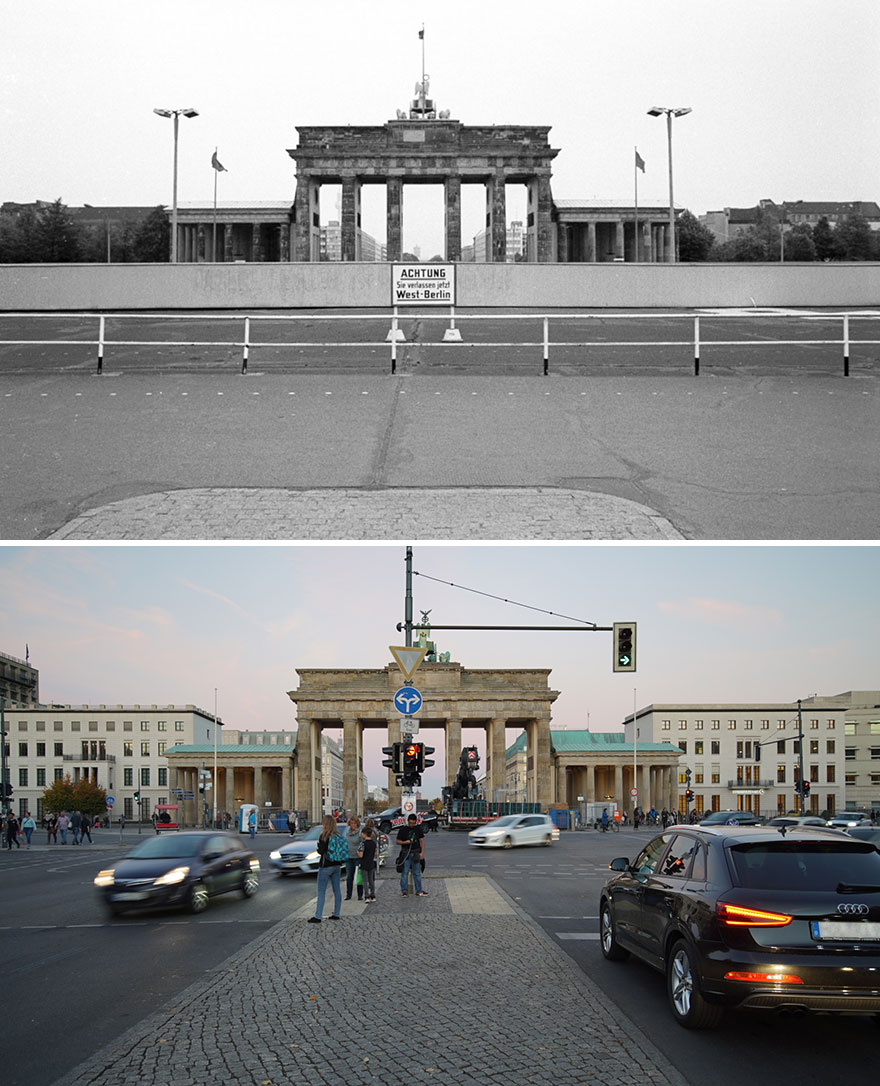
Image credits: refilm.io
The crane, the fences and the portable toilet on the photo of 2018 are remains of the October 3rd German Unity Day celebrations. The photo of 1979 was taken 10 years before this reunification started to happen.
Under construction (1979/2019)
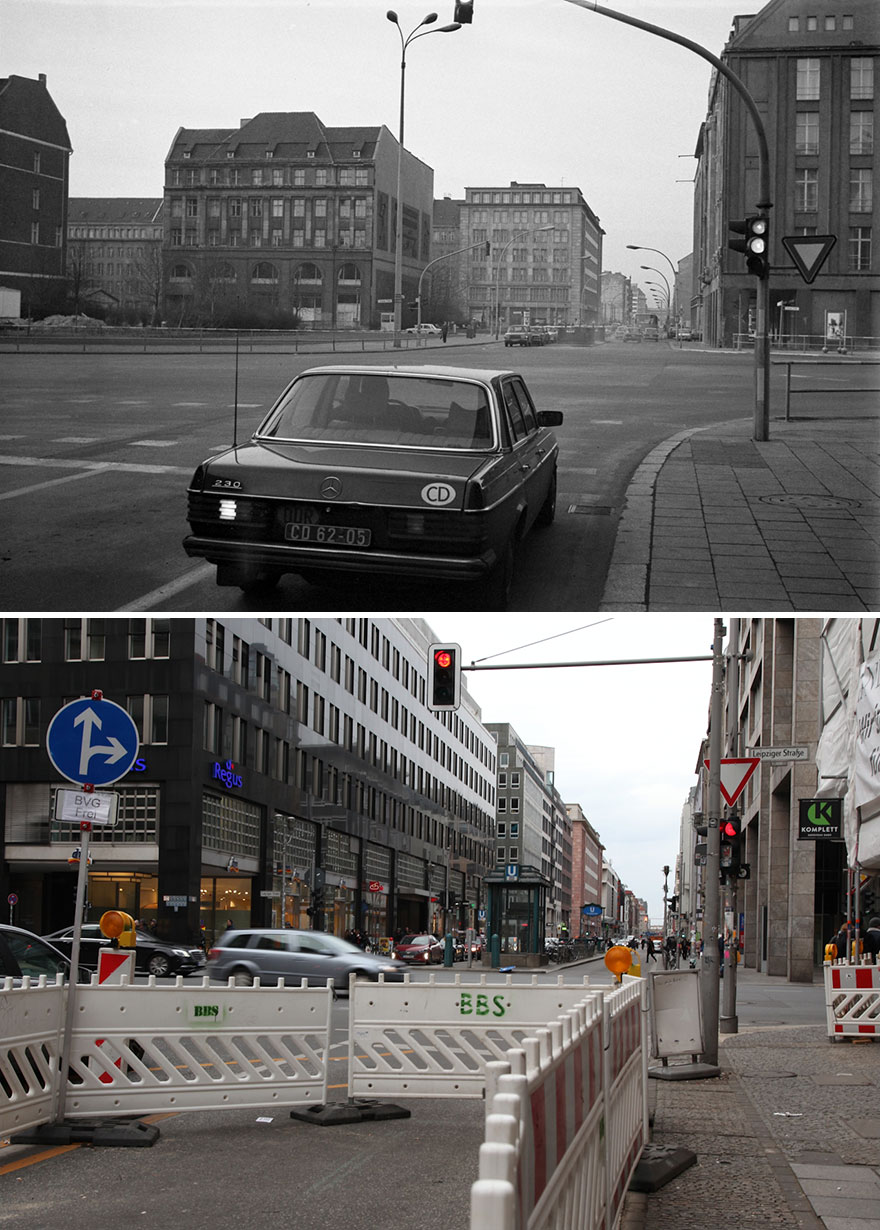
Image credits: refilm.io
A lot has changed at the intersection of Friedrichstraße and Leipziger Straße in Mitte, but the red brick house has not.
The car has a diplomatic registration plate, identifying it as the 5th vehicle of the Turkish “Corps Diplomatique” (CD 62-05).
The construction site in the foreground is part of work that is being done on a house that was beautifully reconstructed some years ago. It seems like it is getting another makeover.
Marheineke Markthalle II (1979/2019)
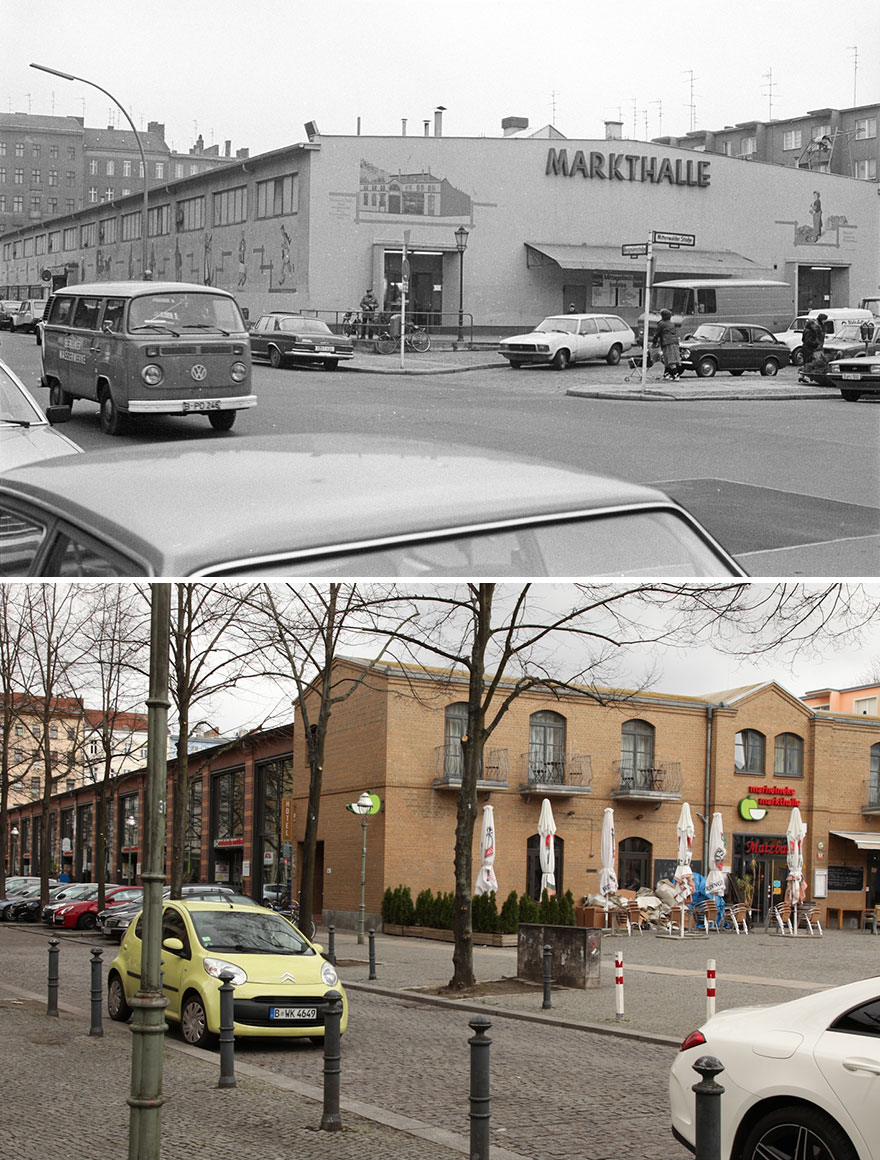
Image credits: refilm.io
The facades of this beautiful indoor market have been restored to their historic state.
Kaufhaus Kato (1979/2019)
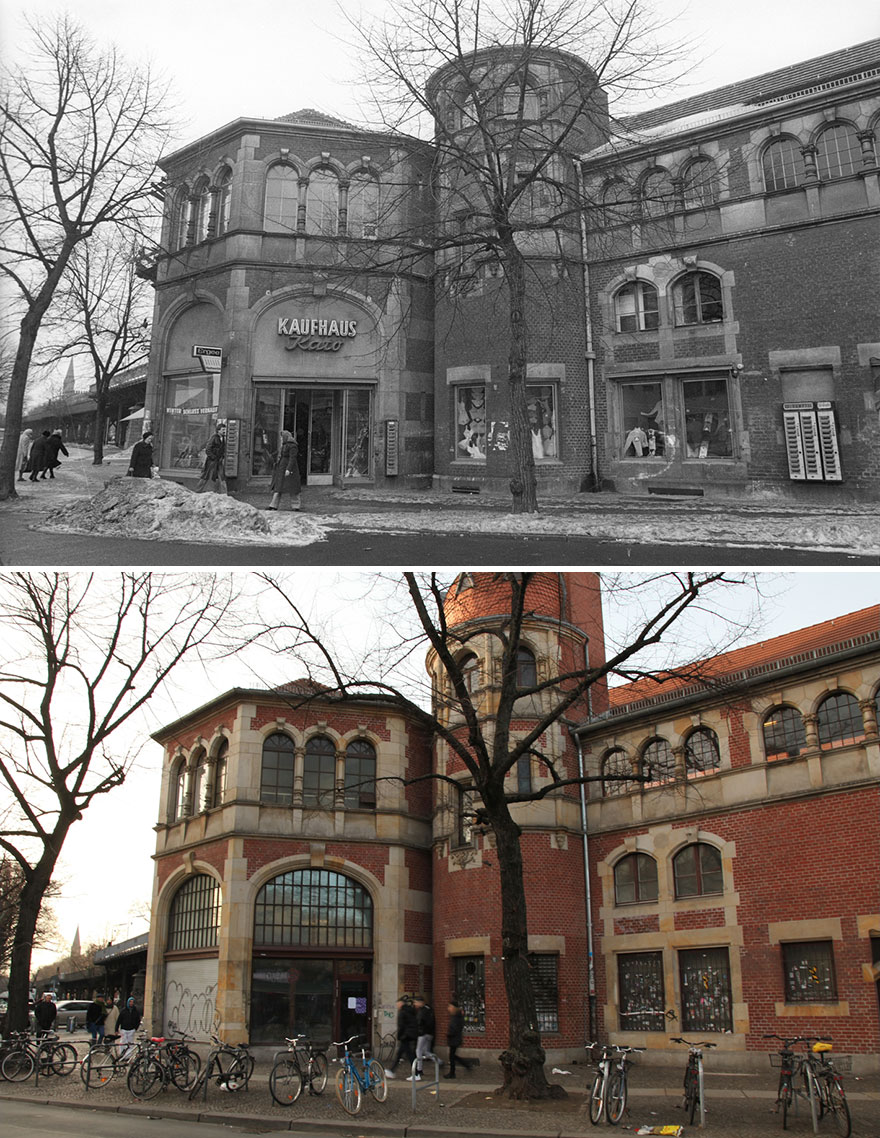
Image credits: refilm.io
Schlesisches Tor in Berlin Kreuzberg. The term “Kaufhaus” suggests a big shopping center, which was not. Today, the place underneath the “U-Bahn” station is home to the club and concert venue Bi Nuu. Note the subtle change the trees went through over the last 40 years.
Friedrichstadt-Palast (1980/2019)
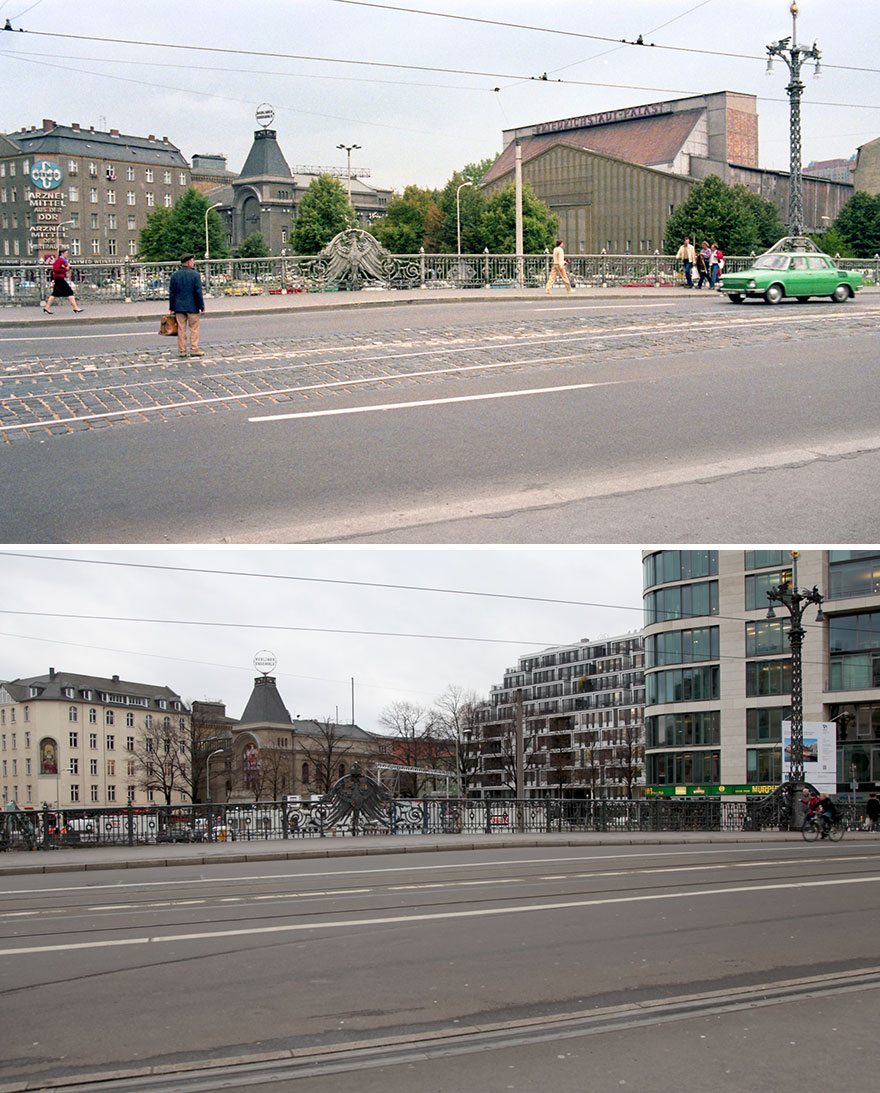
Image credits: refilm.io
The photos were taken on Weidendammer Brücke in Berlin Mitte, showing the Theater am Schiffbauerdamm that hosts the Berliner Ensemble founded by Bertolt Brecht.
The building on the right in the photo of 1980 is the old Friedrichstadt-Palast that was demolished in 1985 and rebuilt one block down on the other side of the street. Note how the building that replaced it mimics the style of the original roof.
The street having the most polluted air in Germany (1980/2018)
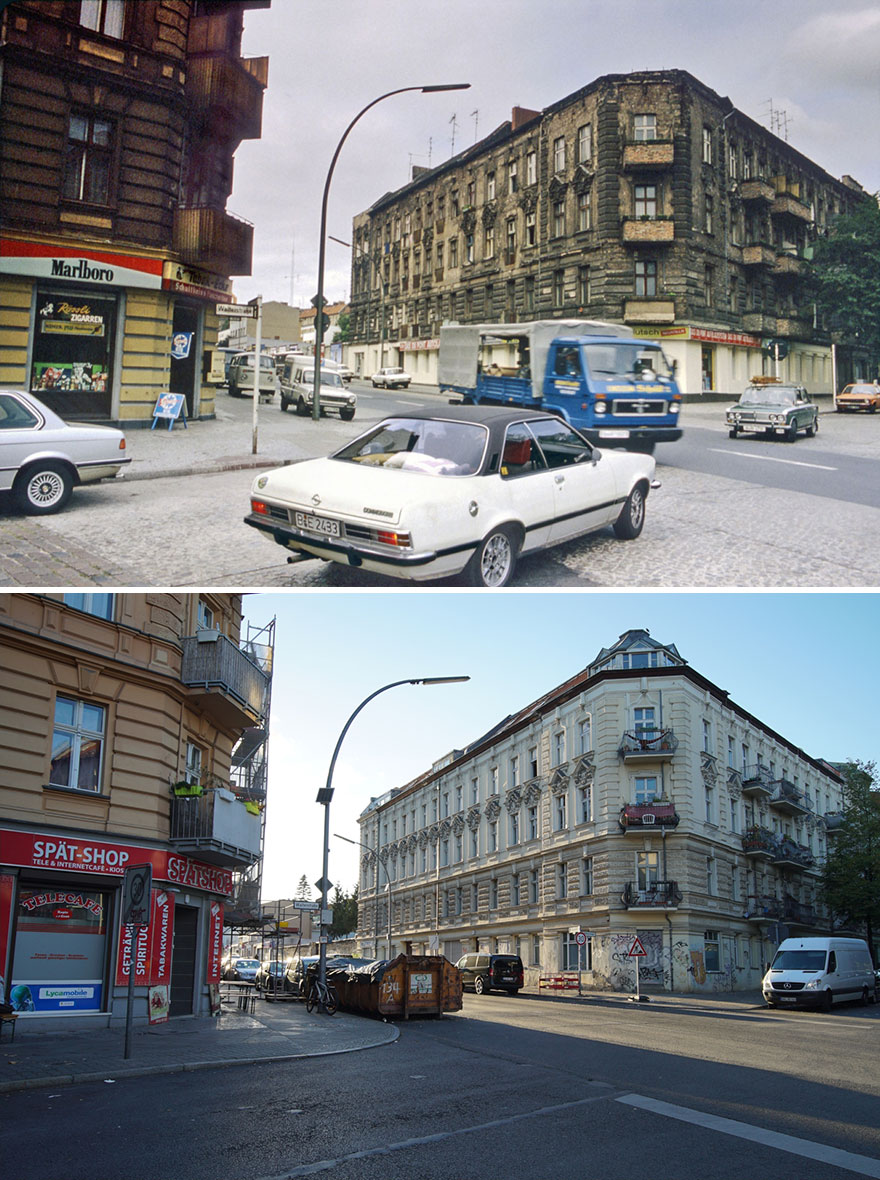
Image credits: refilm.io
Silbersteinstraße in Berlin Neukölln has the most polluted air in Germany.
Berlin Chamissoplatz (1980/2017)
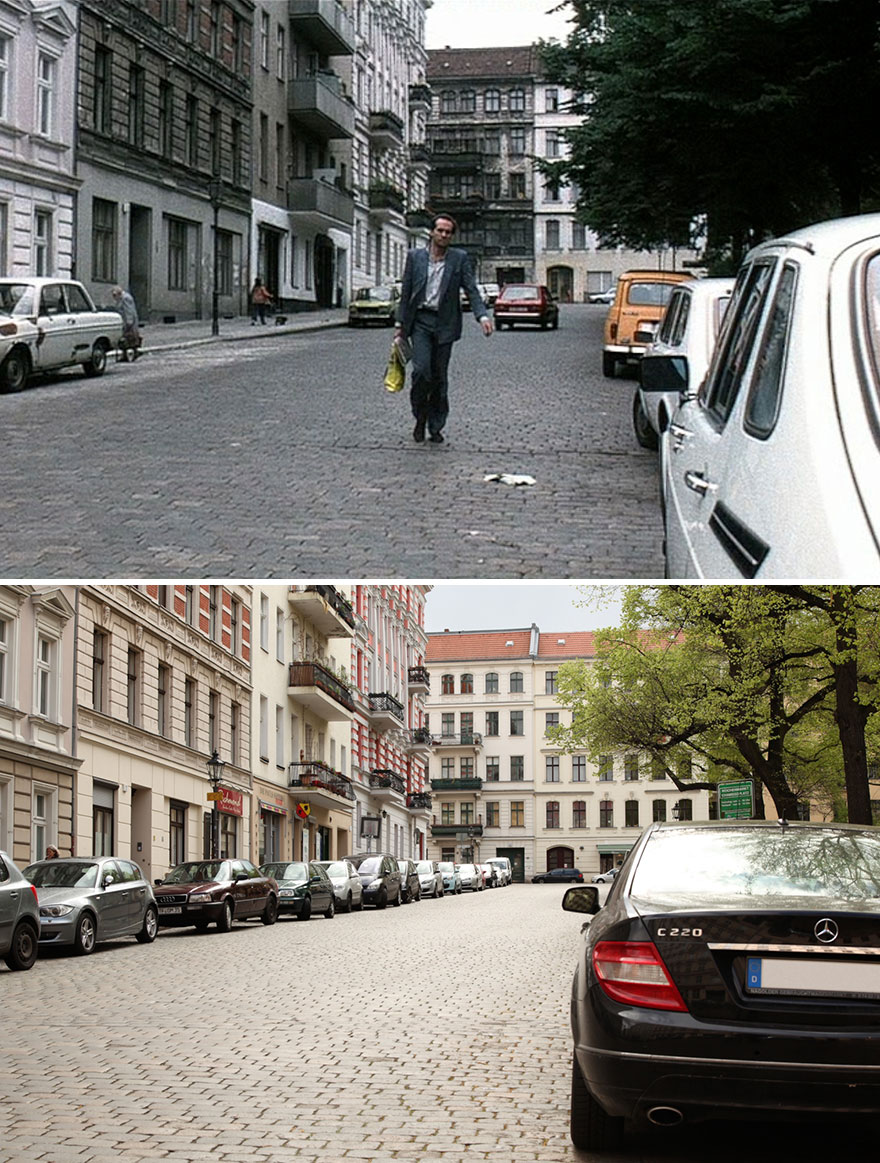
Image credits: refilm.io
As gentrification is the central theme of this beautiful love film, a comparison of then and now seems imperative. The main character, played by Hanns Zischler, can be seen in the center of the movie still.
As the title of the film suggests, the location is on Chamissoplatz in Kreuzberg. The neighborhood consists almost exclusively of beautifully renovated Gründerzeit houses.
Marheineke Markthalle (1981/2019)
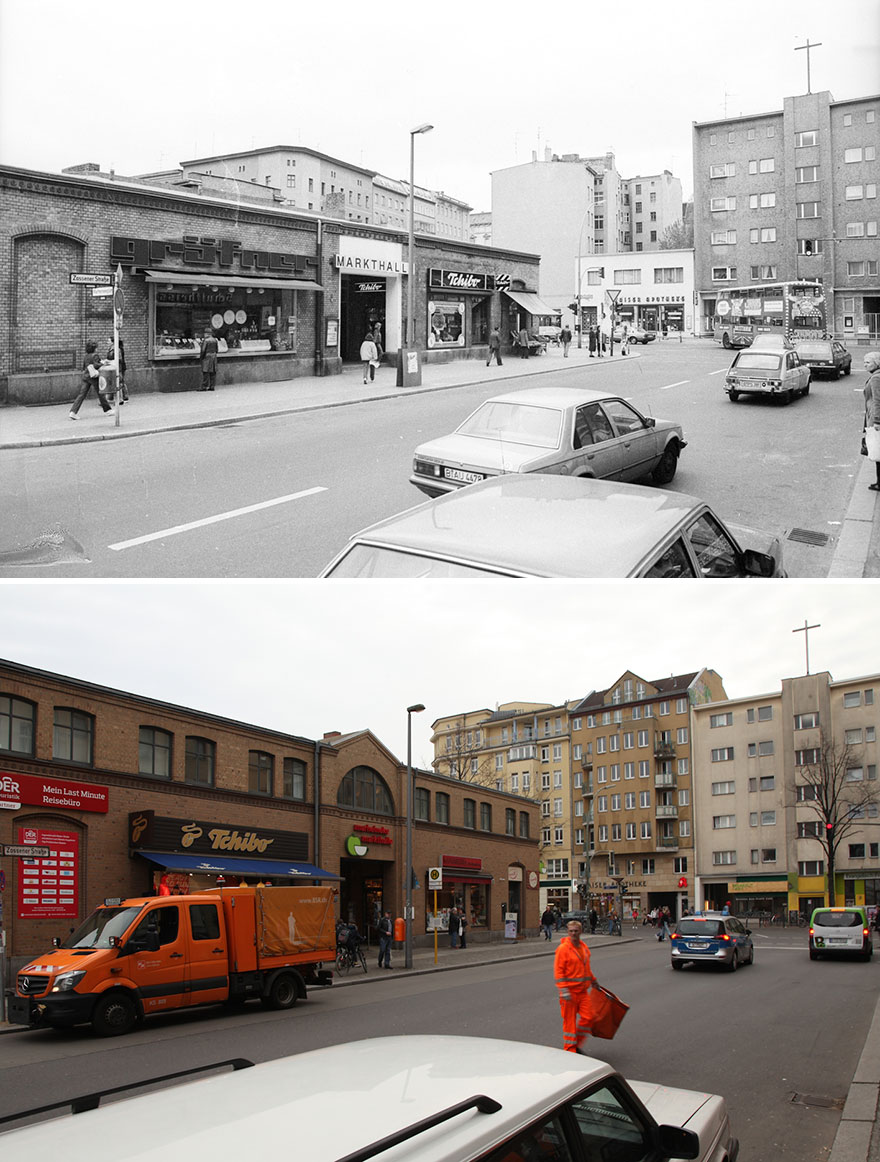
Image credits: refilm.io
Seems like while the area around the corner of Zossener Straße and Bergmannstraße in Berlin Kreuzberg changed a lot over the past 38 years, Tchibo just moved one shop to the left.
Bergmannstraße (1981/2019)
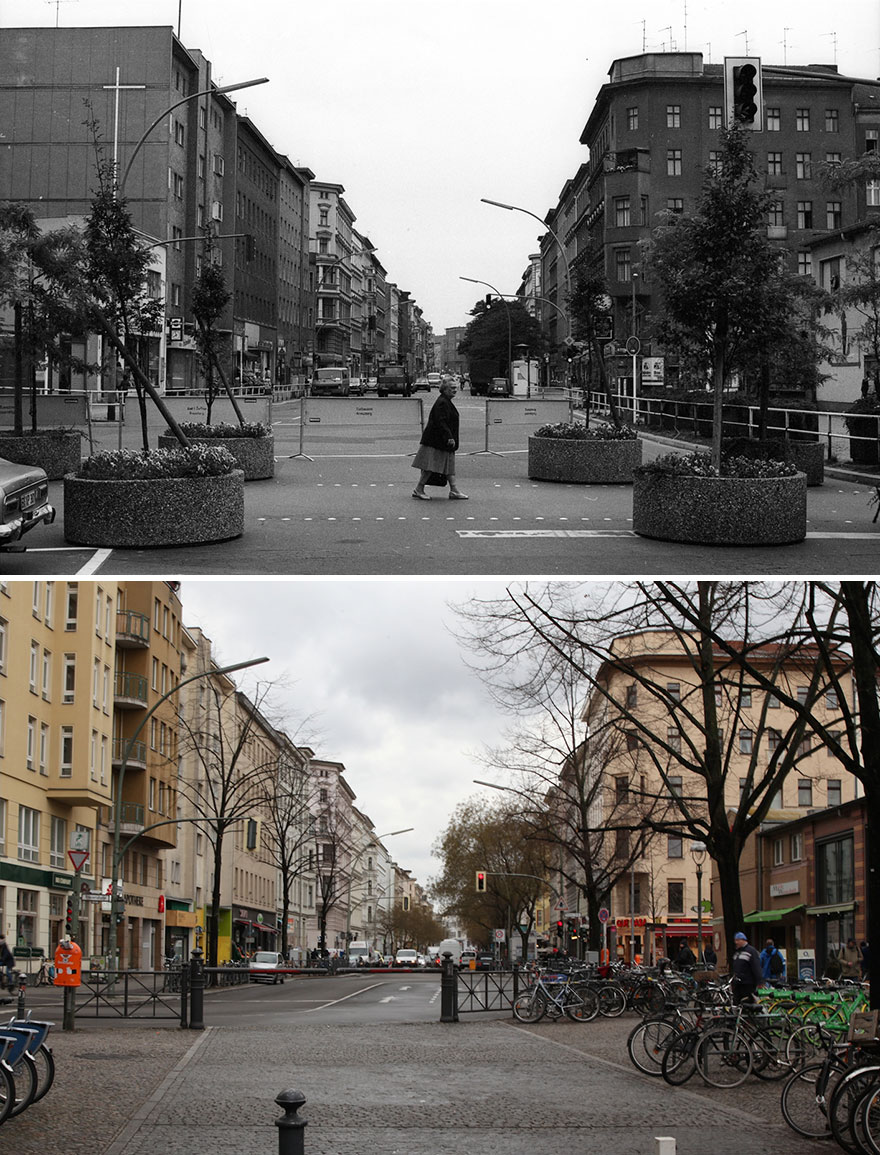
Image credits: refilm.io
On the right side of these photos of Bergmannstraße, you can see the old and the new Marheineke Markthalle. While the cross on the left side of the “then” shot is hidden now, the one on top of the building is still there.
BESETZT (1981/2018)
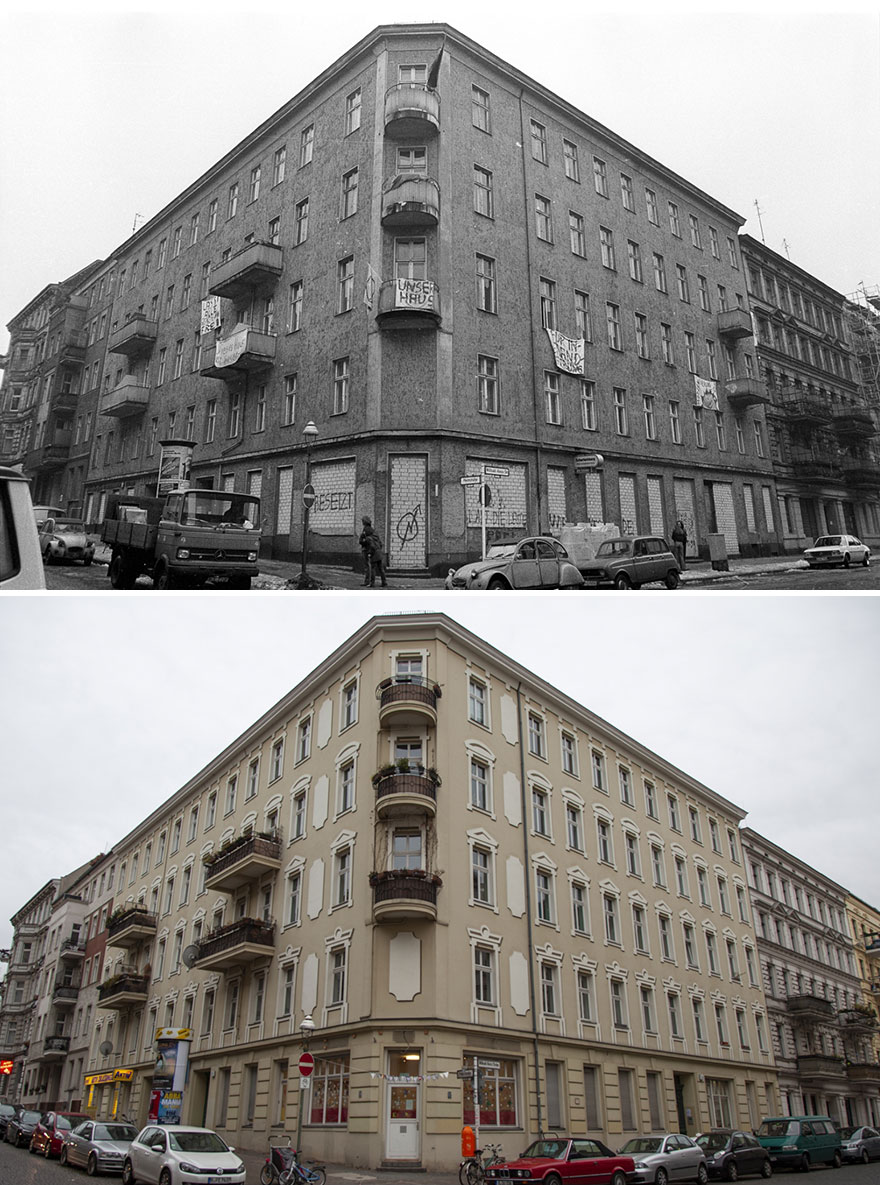
Image credits: refilm.io
A squat at the corner of Heimstraße and Willibald-Alexis-Straße in Berlin Kreuzberg turned back into an apartment building.
Note the bricked windows and doors in the old shot. The graffiti on the window says “BESETZT” (“SQUATTED”) and the one on the front door shows the international squatting symbol.
War damage in the 80s: Gendarmenmarkt (1984/2019)

Image credits: refilm.io
I moved to Berlin about 10 years ago and for me, old buildings were just buildings that looked like this since they were built. Researching old photographs, I realized, that large parts of Berlin stayed in a post-war state for almost 50 years.
This photo shows one of the most touristic sites of the city, the Gendarmenmarkt. This beautiful square in the heart of Berlin was heavily damaged in WWII. Being part of the Soviet sector of Berlin, it was only reconstructed between 1976 and 1993.
Bike ride in Kreuzberg, Berlin (~1985/2018)
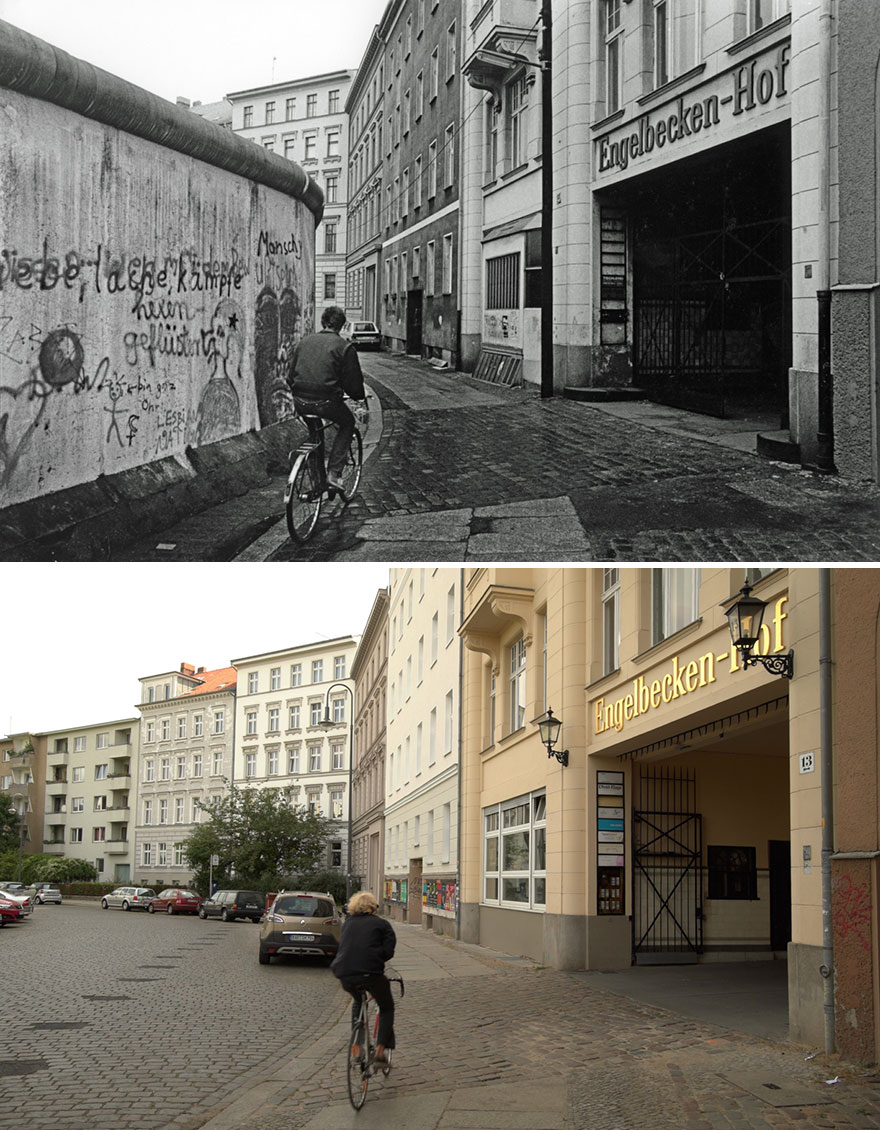
Image credits: refilm.io
As many old photos show, the aisle that the wall cut through the city was used as a “natural” bike path throughout West Berlin. At this particular location, the bumpy cobblestone road forces racebike riders back to the illegality of the sidewalk.
I was told that the black spots in the cobblestone are remainders of some kind of support structure for (possibly an earlier version of) the wall.
War damage in the 80s: Neue Synagoge (1985/2019)
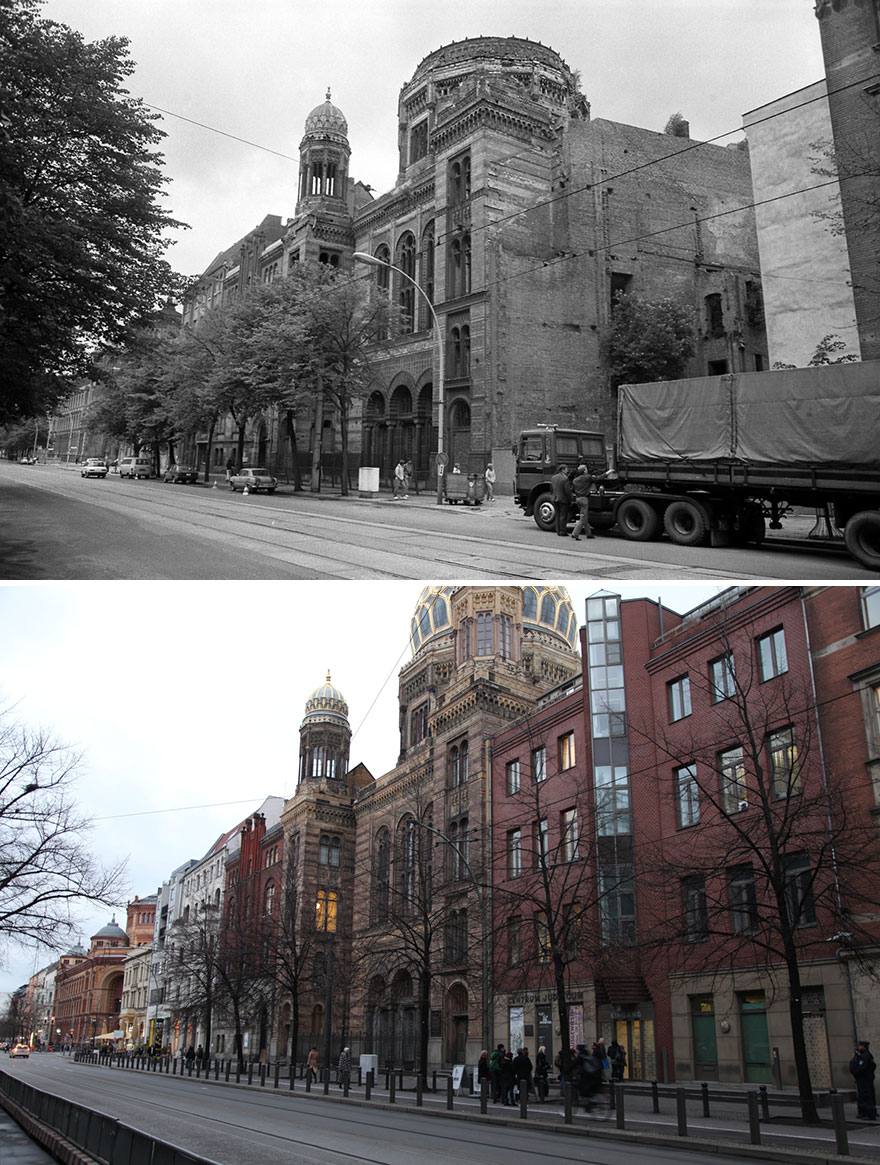
Image credits: refilm.io
The New Synagogue in Oranienburger Straße, Mitte was heavily damaged in World War II. From 1988 to 1993, the structurally intact front of the building was restored.
Cinema turned into Zara (1985/2019)
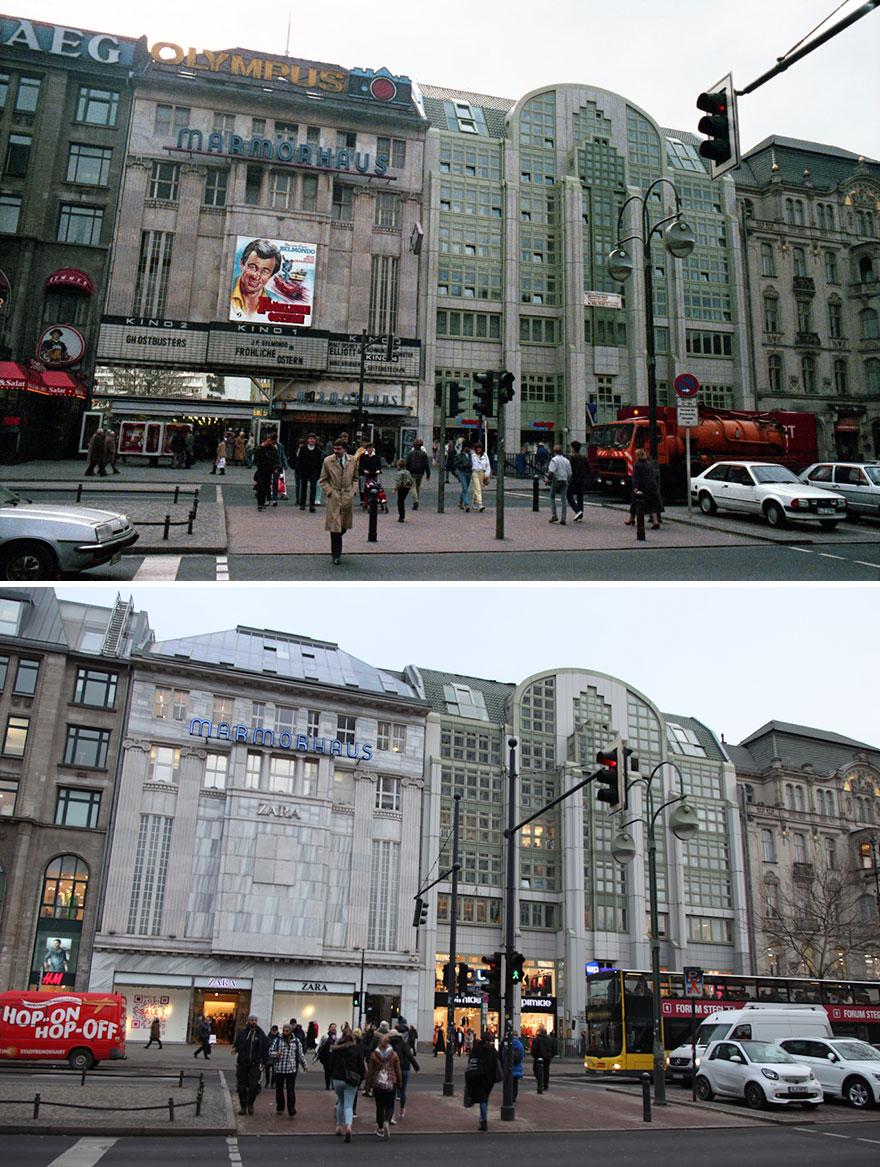
Image credits: refilm.io
At the eastern end of Kurfürstendamm in Berlin Charlottenburg.
Bike ride in Kreuzberg, Berlin II (1986/2018)
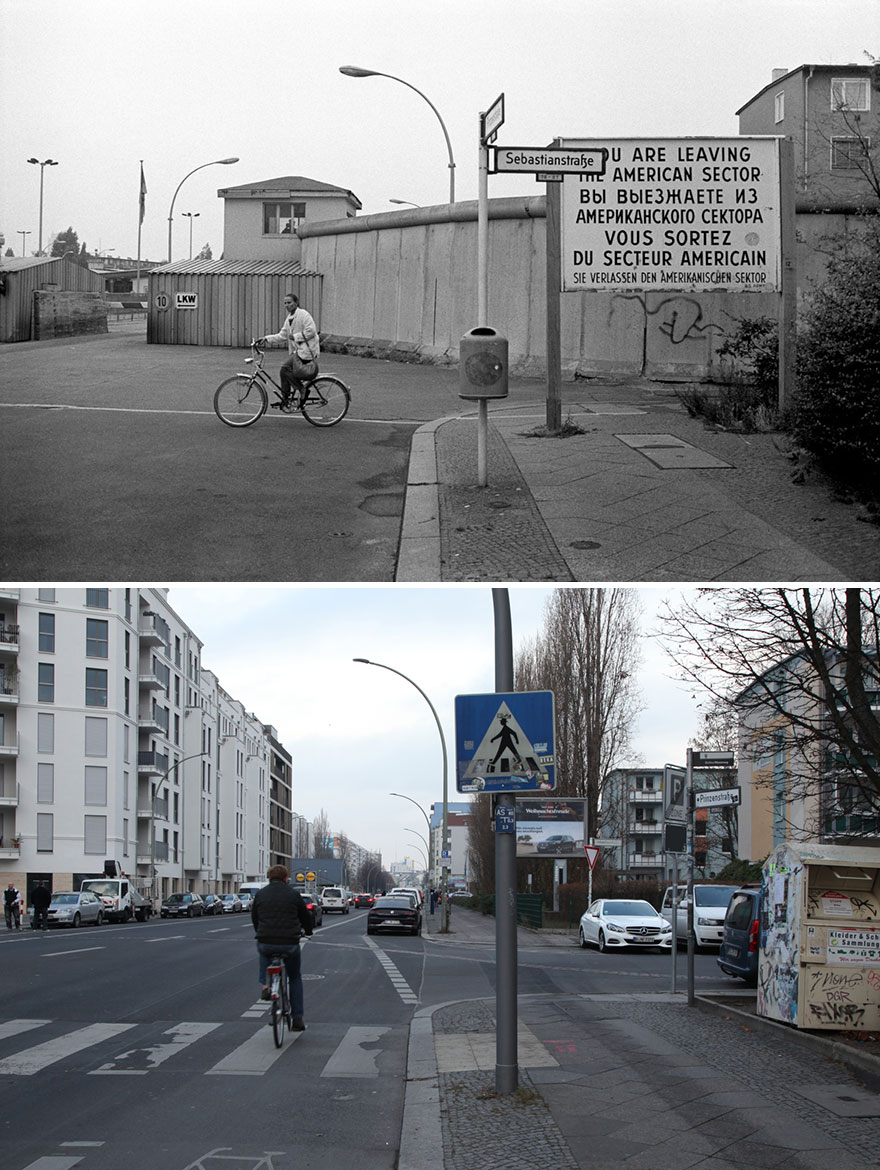
Image credits: refilm.io
This location is right at the north east exit of the “U-Bahn” station “Moritzplatz”. The old photo shows the border checkpoint in Prinzenstraße, seen from the western side of the Berlin Wall.
Dive bar turns into Thai restaurant (1986/2018)
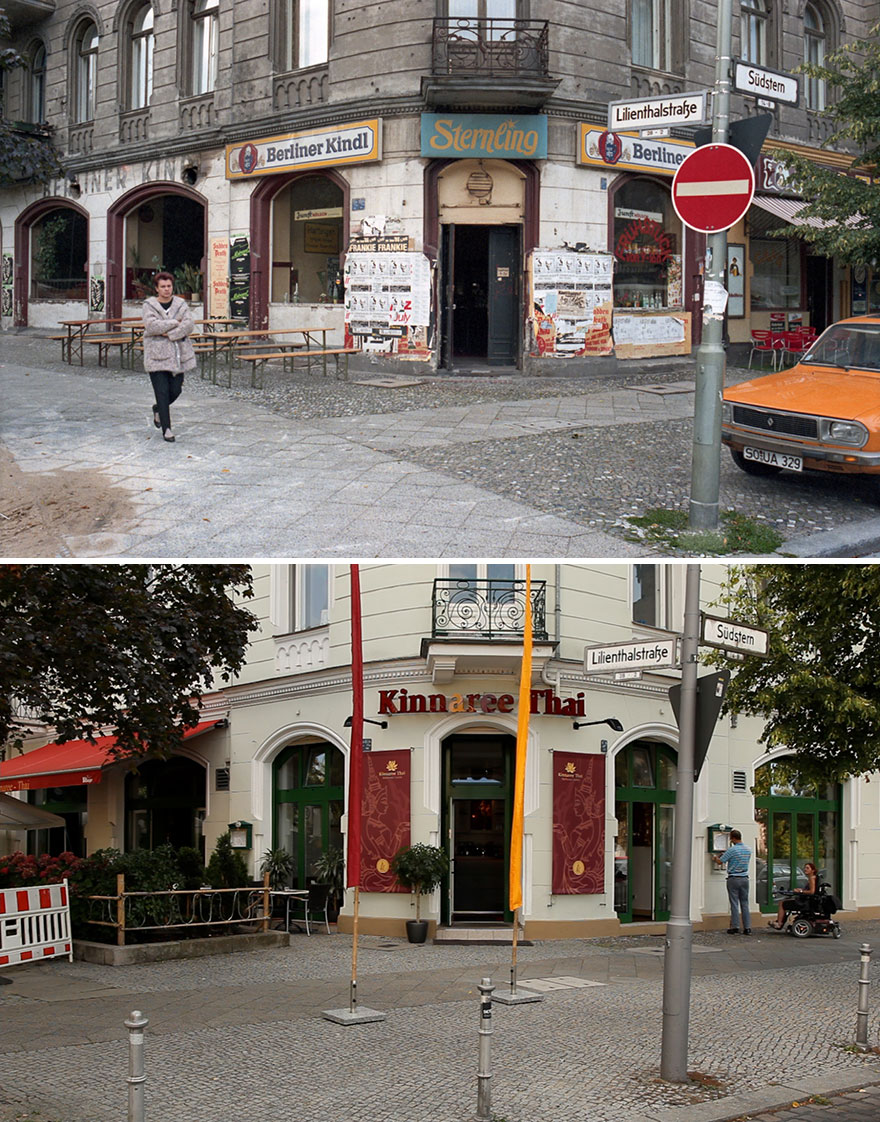
Image credits: refilm.io
One of the few things that seem untouched are the street signs. Some of them even have the same stains.
Friedrichstraße (1986/2018)
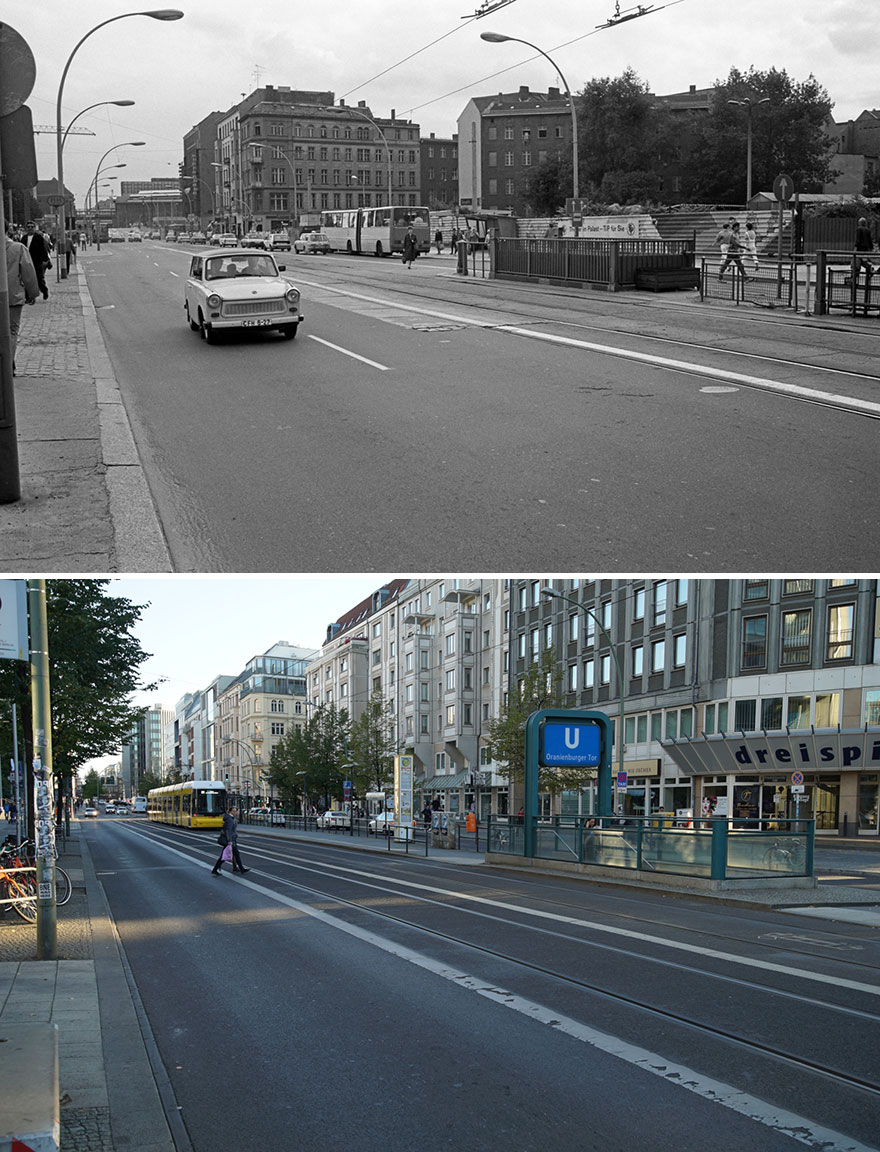
Image credits: refilm.io
It is incredible how much the center of one of the largest cities in Europe has changed in only 32 years. Those shots were taken at “U-Bahn” station “Oranienburger Tor”. In the far distance, one can see the “S-Bahn” bridge crossing the street.
A slowly growing tree (1986/2019)
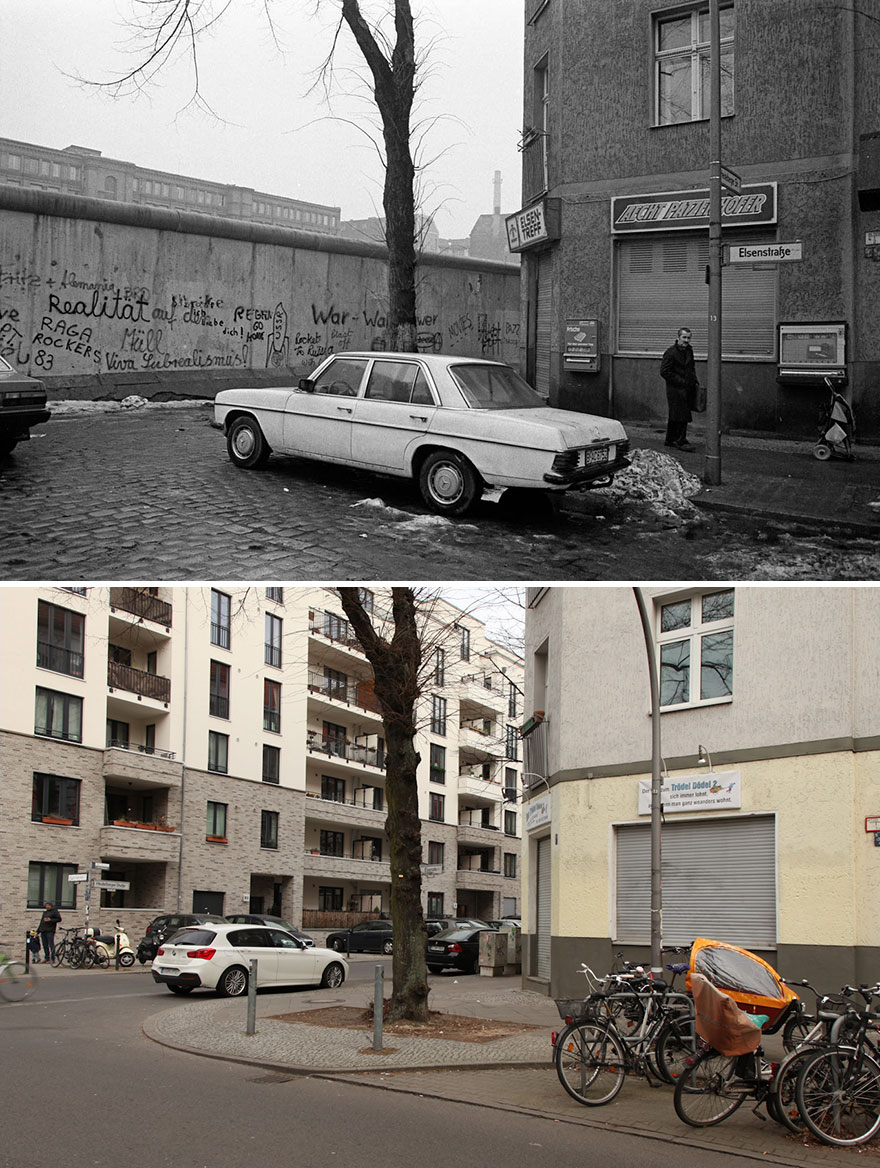
Image credits: refilm.io
The bar turned into a thrift shop on the corner of Heidelberger Straße and Elsenstraße in Neukölln, Berlin.
The buildings provide a connection to the past and trees are living reminders of the evolvement of life despite all the changes. Even though the tree in the photo did not grow much, the city around it changed considerably.
In the location where the Wall used to be, one can see the cobblestone memorial line that was installed throughout the city.
Some places don’t change, even in Berlin (1986/2018)
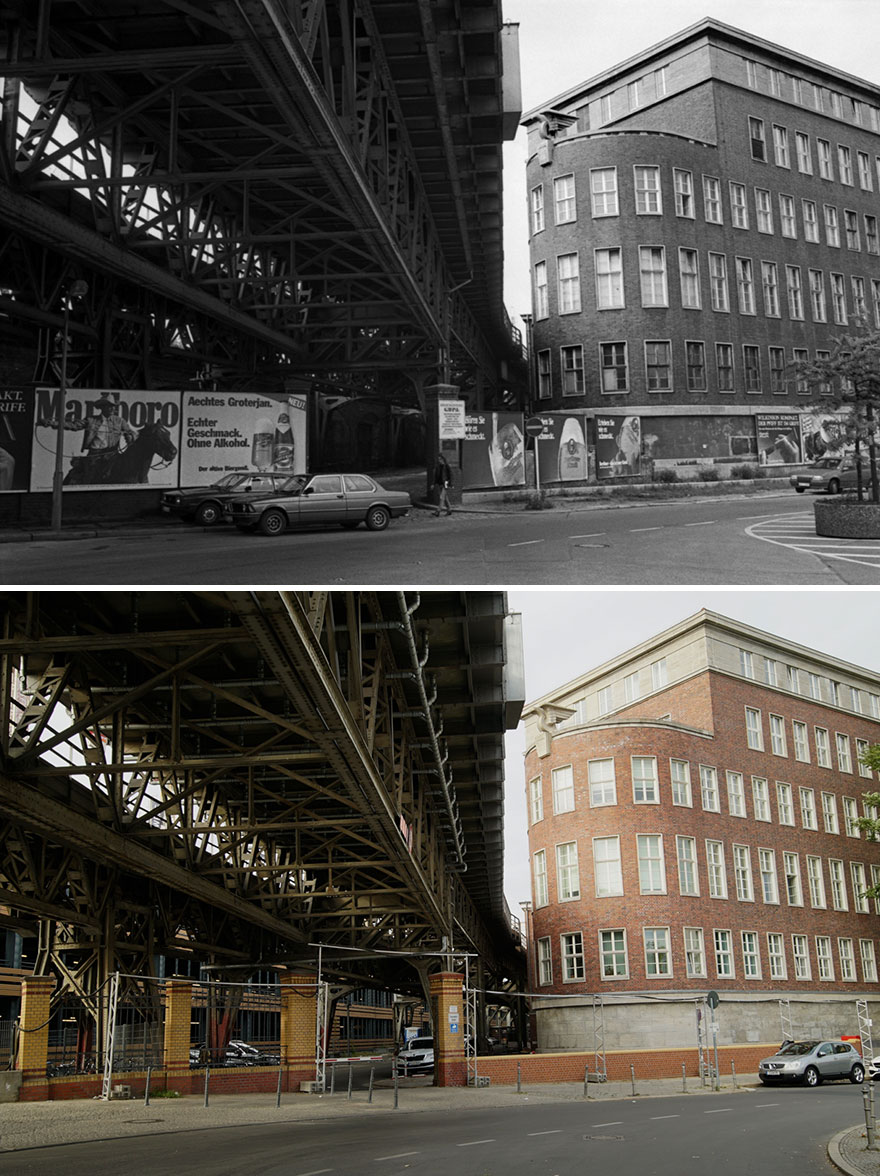
Image credits: refilm.io
In Berlin Gleisdreieck, only the cars and ads seem to have changed.
This spot has also been popular filming location. Among others, scenes from “Just a Gigolo” starring David Bowie and Wim Wenders’s “Wings of Desire” were filmed there.
Wings of Desire: Bruno Ganz and Otto Sander (1987/2017)
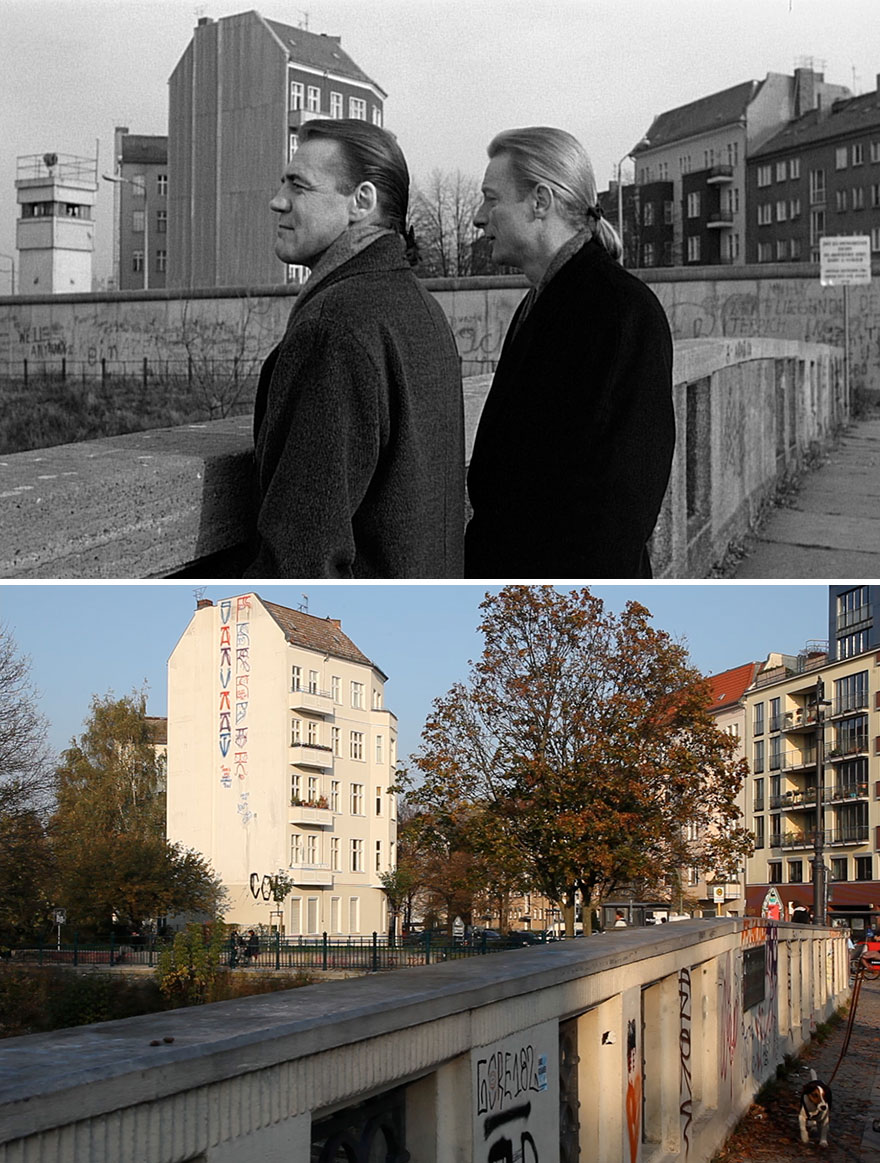
Image credits: refilm.io
Bruno Ganz and Otto Sander are standing on the Lohmühlenbrücke in Neukölln, Berlin. That is one of the most beautiful movie scenes of all time from “Wings of Desire” by Wim Wenders. At this location, the wall was running across the road, ironically blocking a bridge that was built to connect the neighborhoods of Neukölln and Treptow.
Wings of Desire: A wall on a bridge (1987/2017)
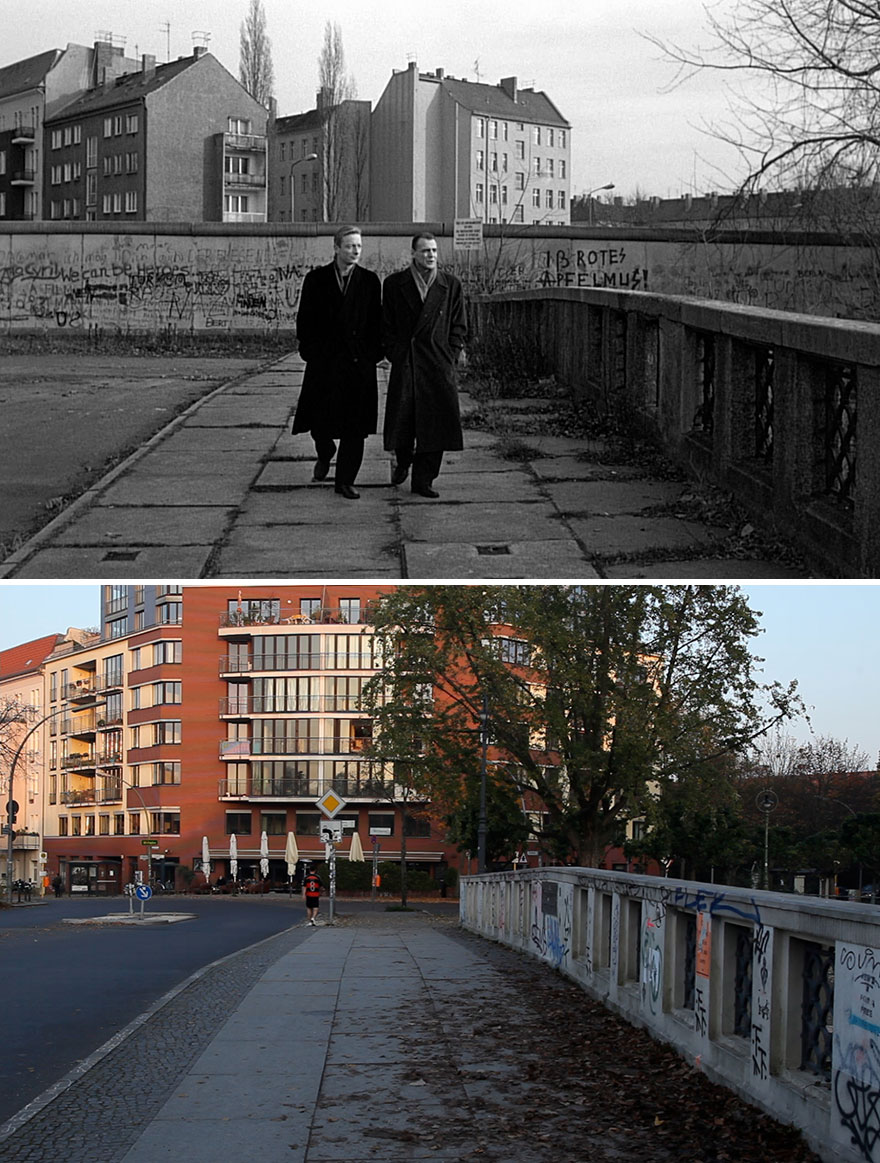
Image credits: refilm.io
In this iconic scene from Wim Wenders’s masterpiece “Wings of Desire”, the two angels, played by Bruno Ganz and the late Otto Sander, are having a conversation on the Lohmühlenbrücke in Berlin. At the far end of the bridge, the road is blocked by the wall, separating Neukölln in the west from Treptow in the east.
Wings of Desire: Iß ROTES APFELMUS! (1987/2017)
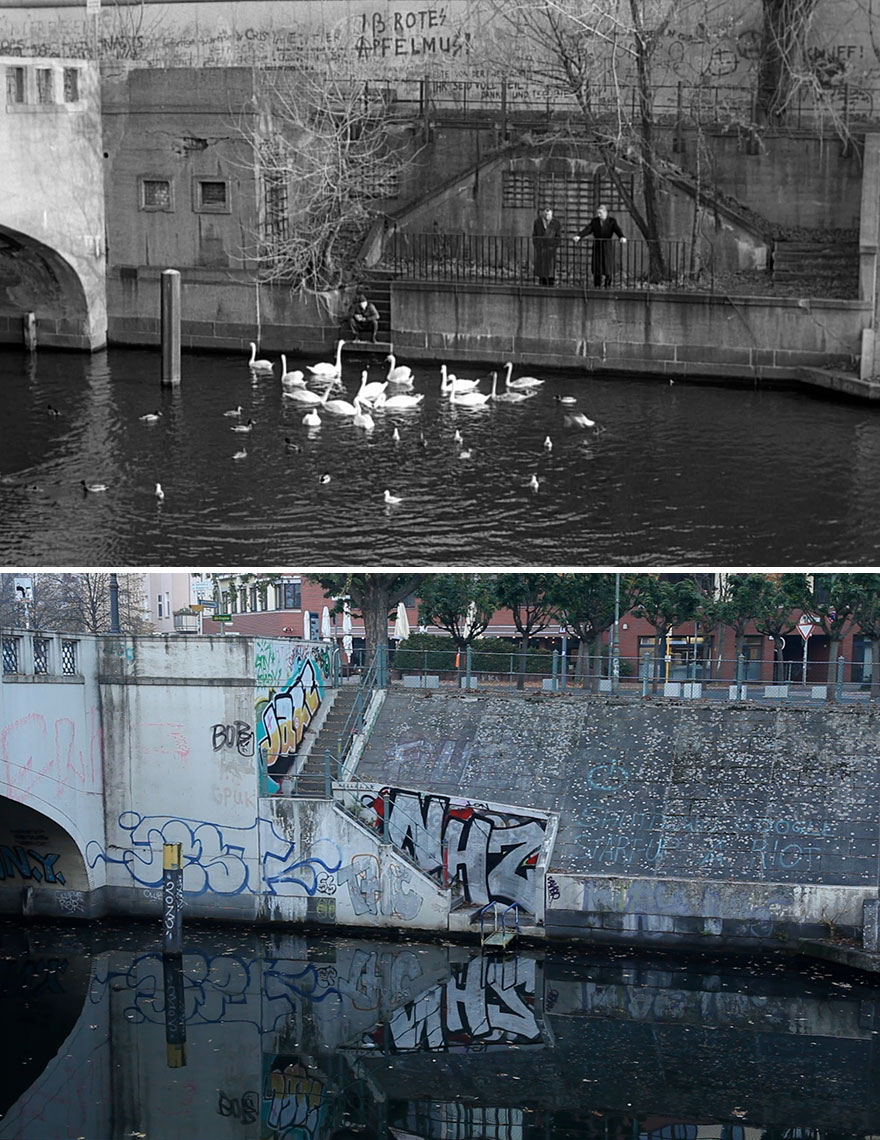
Image credits: refilm.io
The graffiti on the wall seen in the movie “Wings of Desire” by Wim Wenders is still present. The famous saying “Iß ROTES APFELMUS” means “EAT RED APPLE SAUCE”.
The bridge on the right was blocked by the wall, leaving only a small path along the river bank to get to the Neukölln part on the Treptow side of the canal.
Onkenstraße (1990/2019)
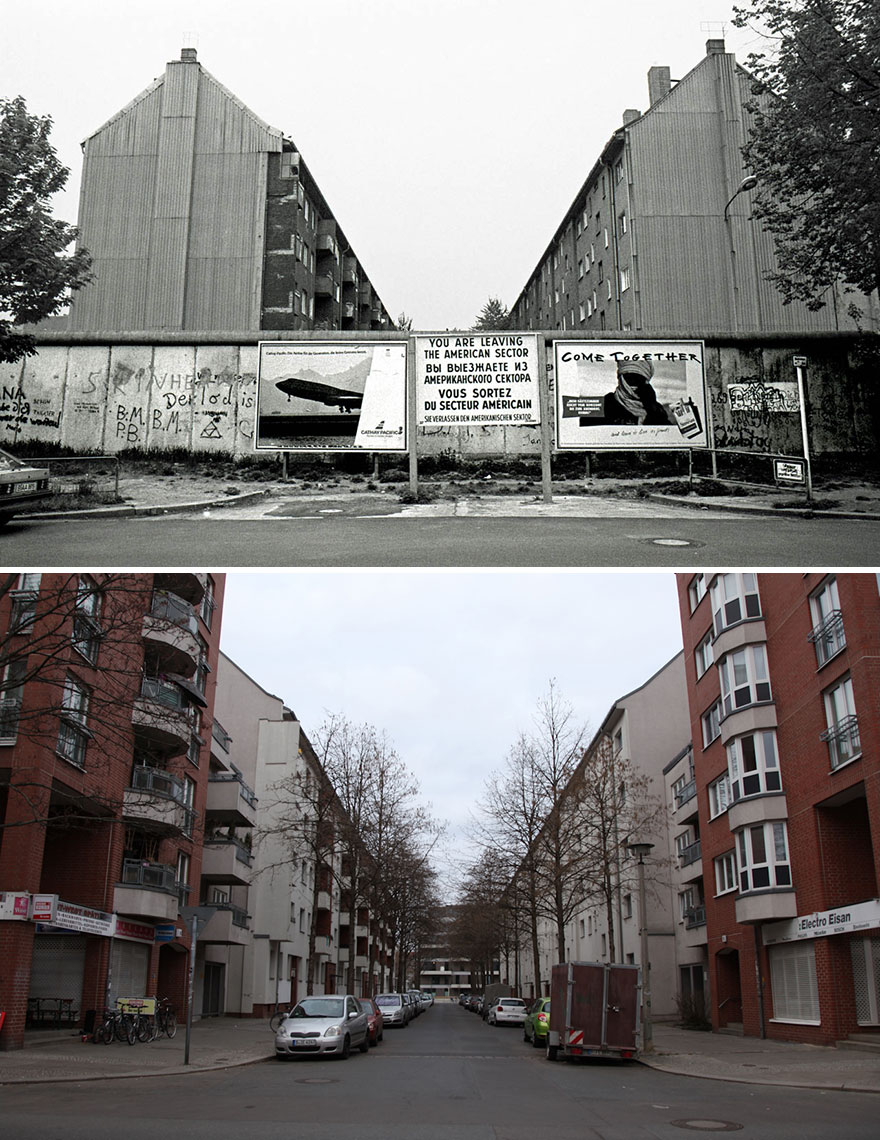
Image credits: refilm.io
The Berlin Wall between two districts: Neukölln and Treptow.
Inside the death zone (1990/2018)
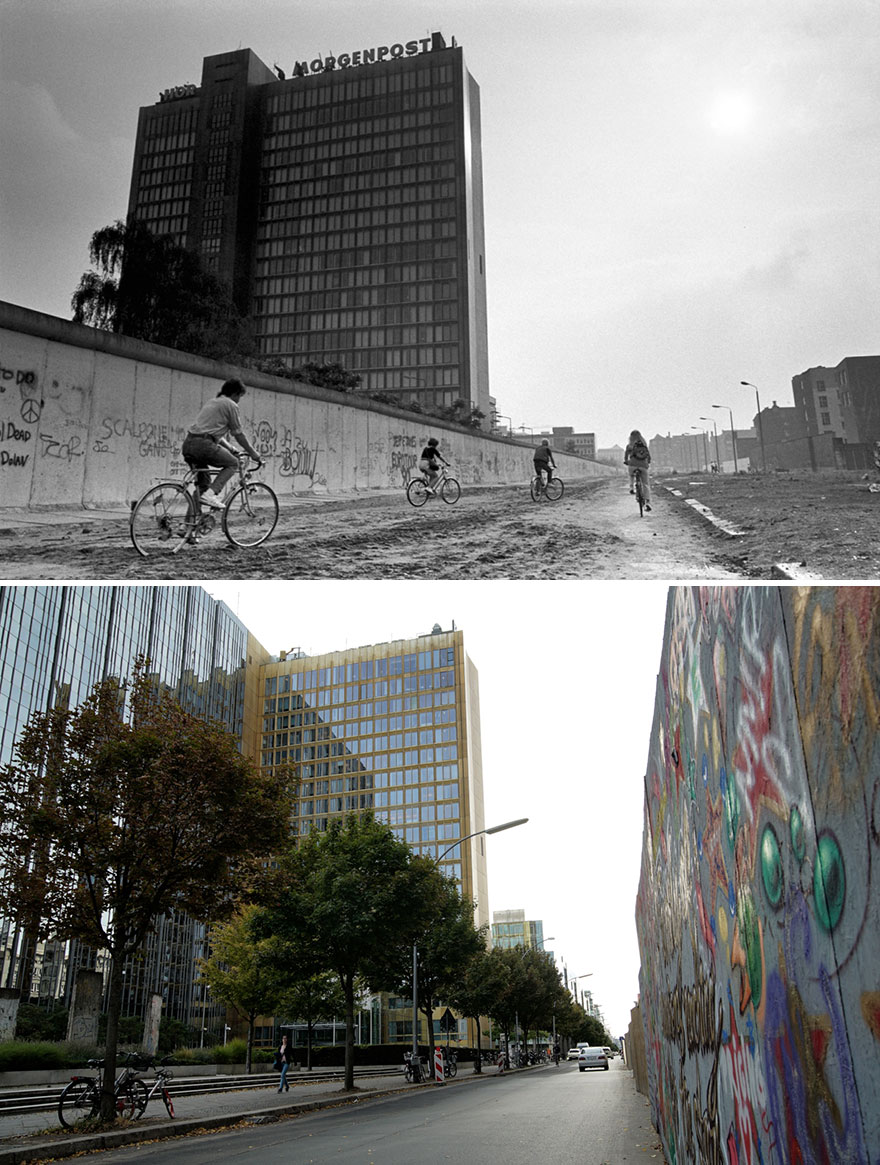
Image credits: refilm.io
This amazing photo by Chris John Dewitt depicts bikers riding down Zimmerstraße towards Checkpoint Charlie inside what used to be the death zone (Todesstreifen). This must have been captured shortly after the wall came down. At that time, the western wall (on the left) was still standing but there were already graffitis on it. On the right side, the eastern border structures, including lights to illuminate the “no man’s land”, can be seen. If you look closely, you can see the memorial line made from cobblestone on the street in the photo of 2018.
The building on the left hosts the Axel Springer publishing house that publishes a number of major newspapers like “Berliner Morgenpost”, “Welt”, and most notoriously the largest German newspaper “Bild”. While the building has been extended impressively in the photo of 2018, a new “Axel Springer” building is being constructed behind the fence on the right.
A falling wall (1990/2018)

Berlin at the corner of Kommandantenstraße and Lindenstraße (then) / Axel-Springer-Straße (now).
Everything changes but the Mercedes Benz (1990/2018)
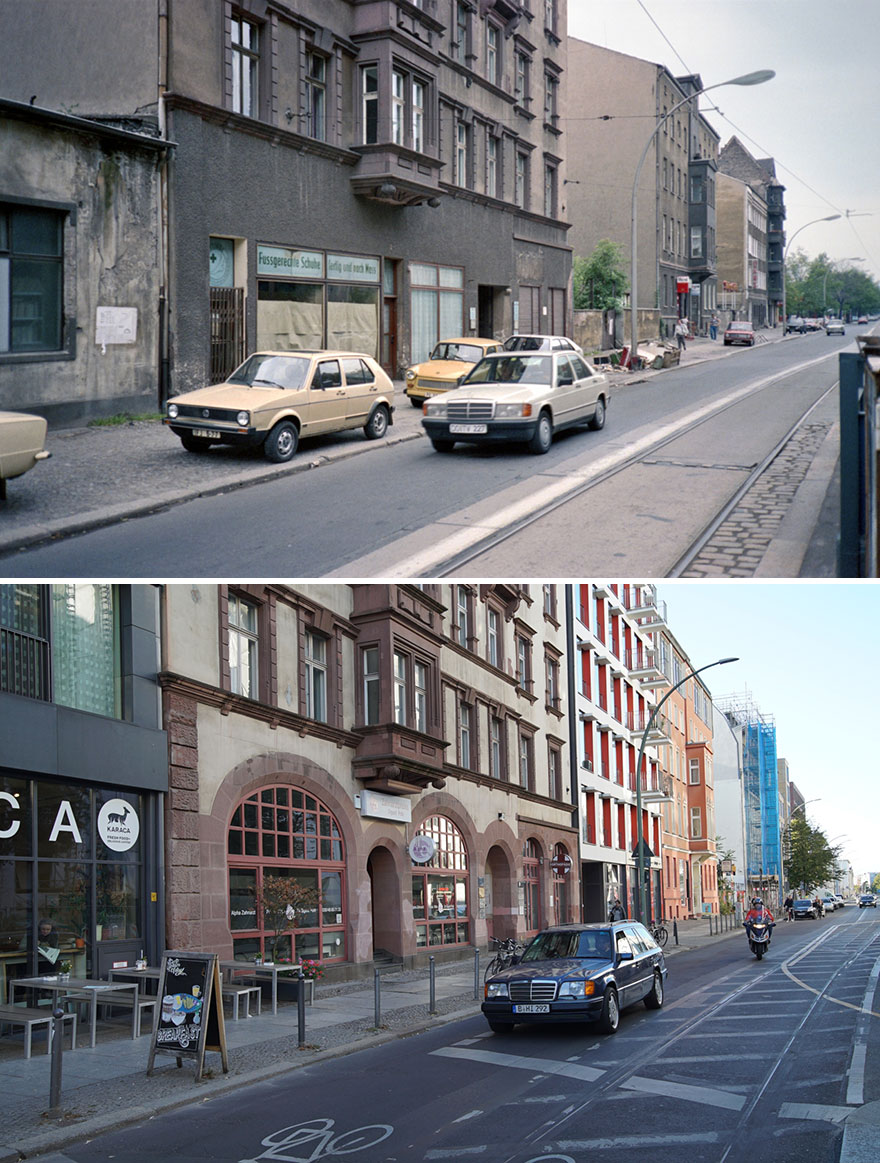
Image credits: refilm.io
I was lucky to catch a Mercedes in the exact same spot the original photographer did in Mitte.
The trains they are changing (1990/2018)
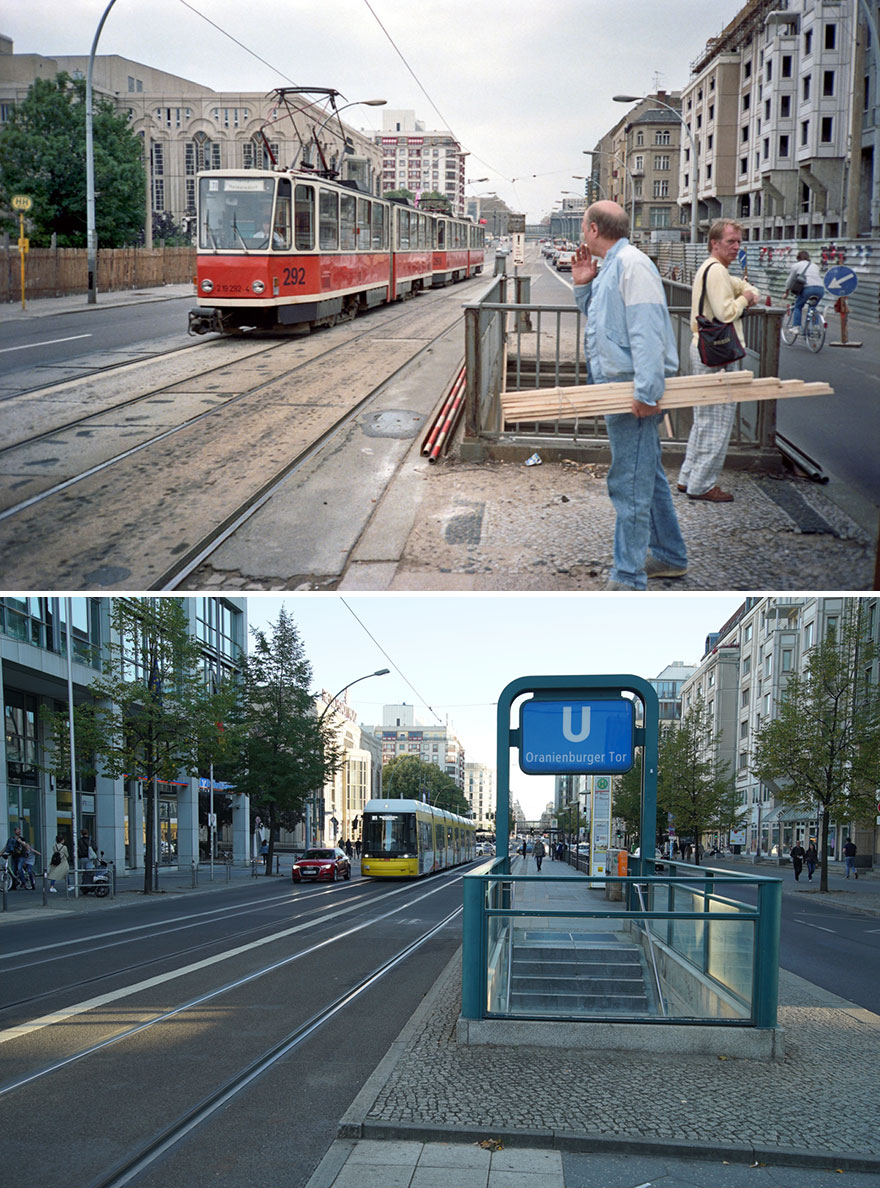
Image credits: refilm.io
Different generations of the tram in Friedrichstraße in front of Friedrichstadtpalast.
Wall-Street Gallery (1990/2018)
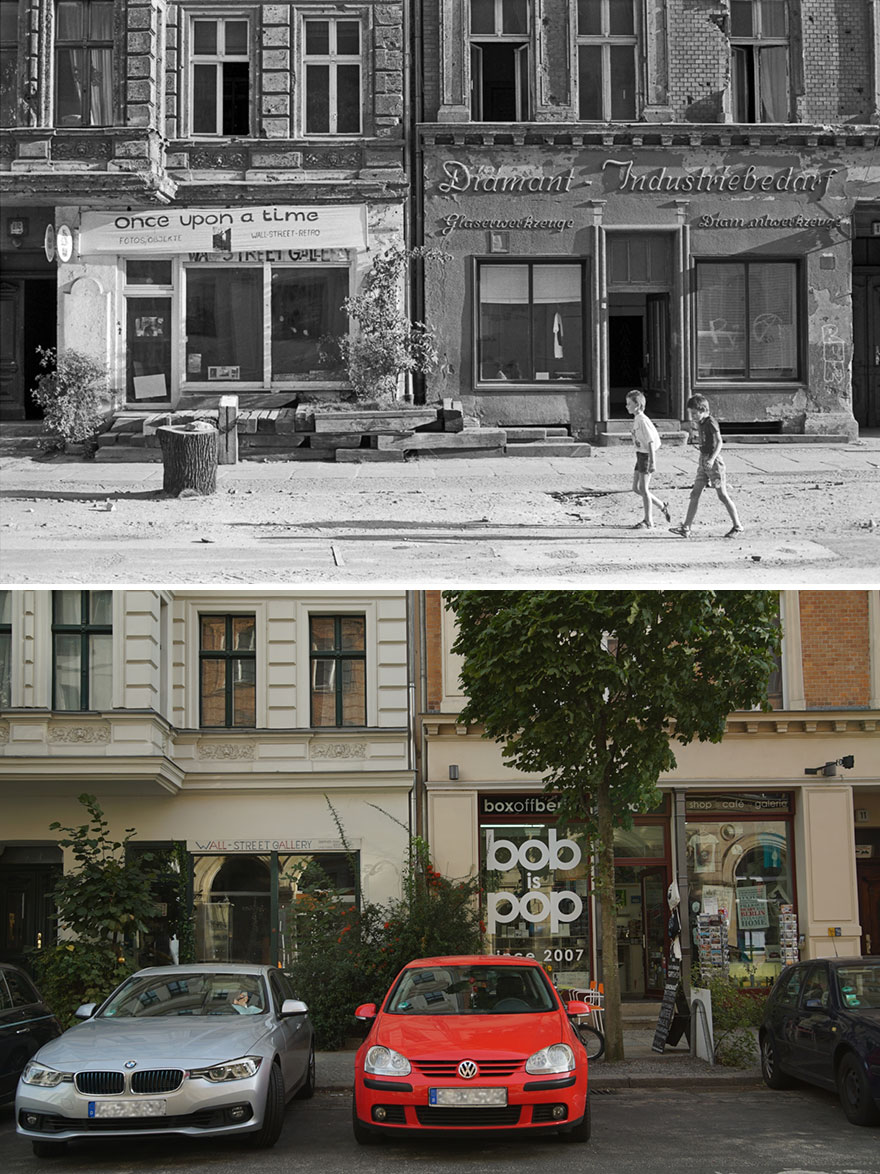
Image credits: refilm.io
The Wall-Street Gallery has been a “rock in the surf” over the years of rapid change in Berlin.
Stolen parts (1991/2018)

Image credits: refilm.io
On New Year’s Eve of 1989, people climbed the Brandenburg Gate and stole parts of the Quadriga. Because of this damage and the fact that its condition was neglected since the construction of the Wall, the Quadriga was subsequently taken down for restoration. During this process, some parts that were removed by the GDR government in 1958 (the “Iron Cross” and the “Prussian eagle”) were also reintroduced.
Facade paintings in Berlin Mitte (1993/2018)
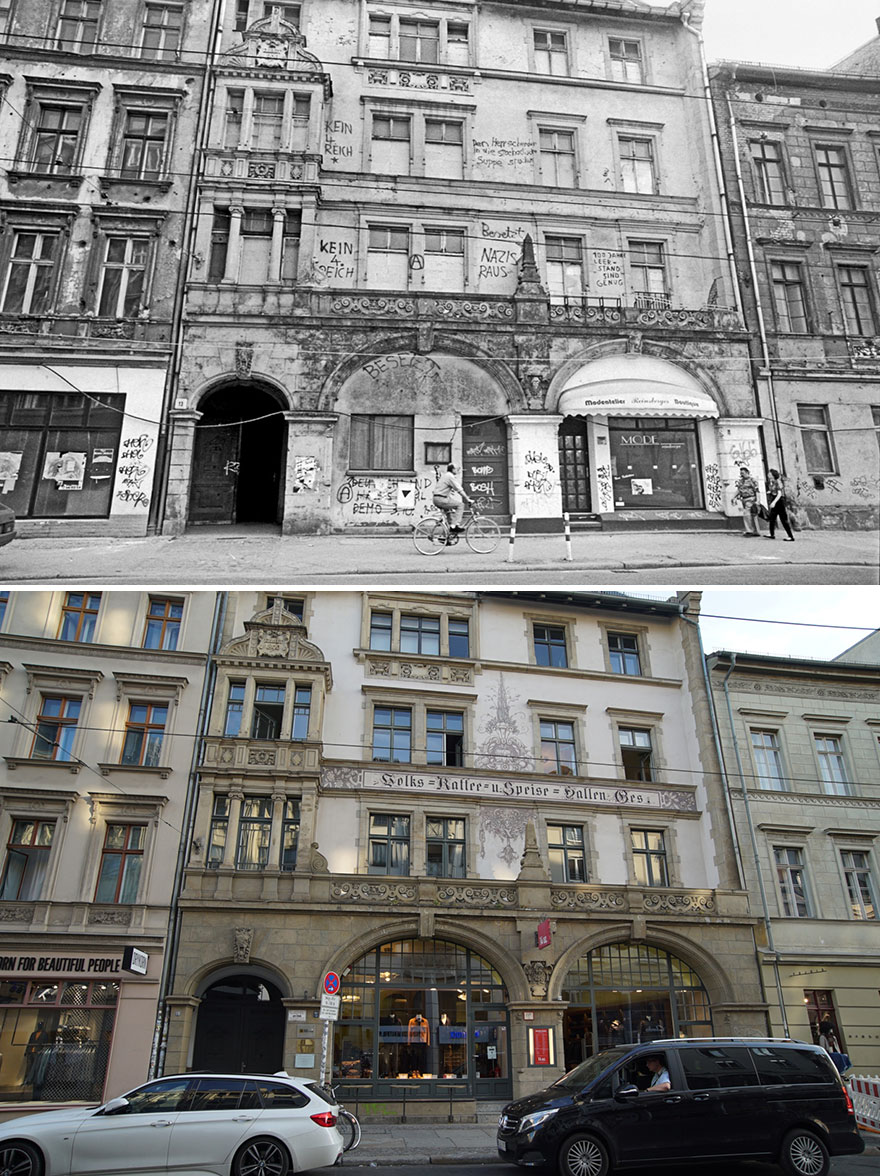
Image credits: refilm.io
Most of the facades in Neue Schönhauser Straße have gone through this transition in the last 25 years.
Bridges and pipes (1995/2018)
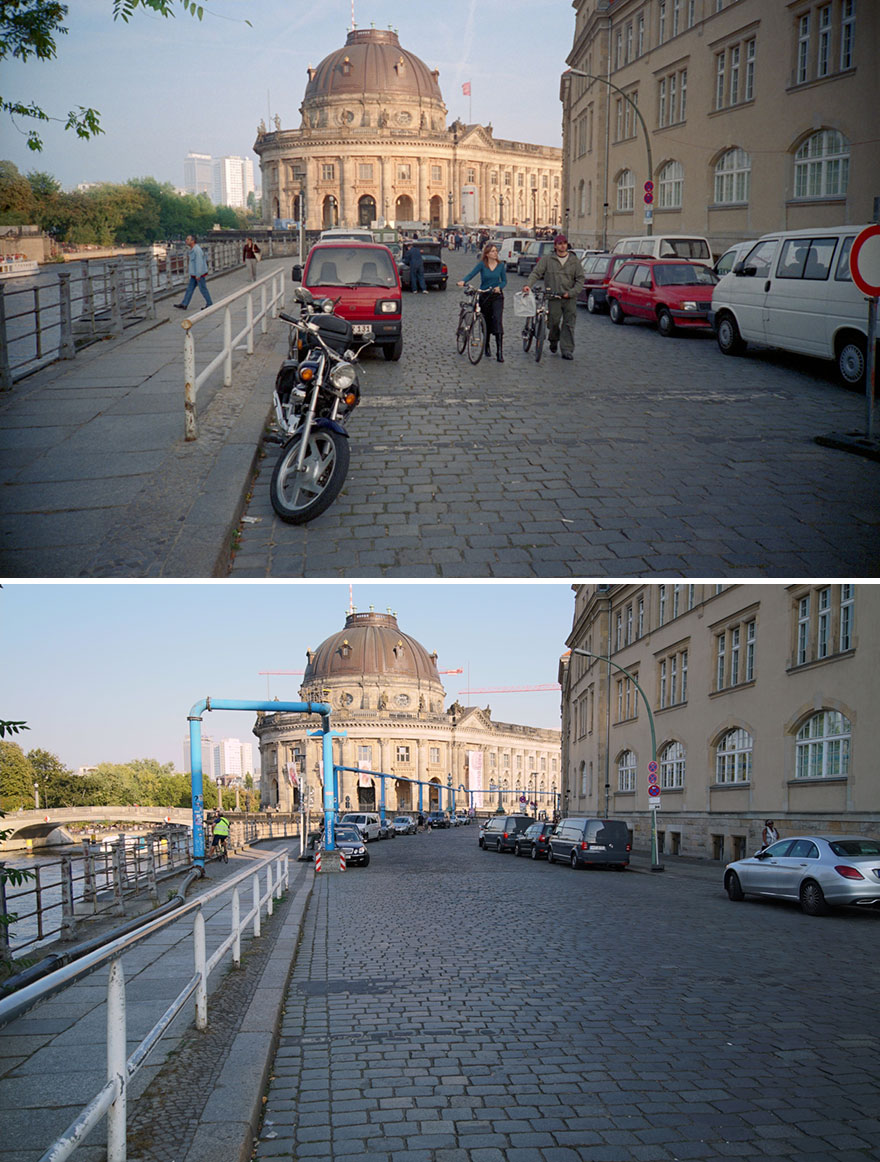
Image credits: refilm.io
In the old photo, the bridge (Monbijoubrücke) on the left side is missing. Opened in 1904, it was blown up by the Wehrmacht to hold back the advance of the Red Army. In the GDR, it was replaced by a temporary steel bridge that was removed after the wall came down.
In 2006, the bridge that can be seen on the photo of 2018 was opened. On Sundays in the summertime, classical open-air concerts are performed in front of Bodemuseum (the building in the center) and the bridge is filled with people.
Blue and pink pipes are a familiar sight all over Berlin. They are used to pump water resulting from the high groundwater level from construction sites into the Spree river. The pipes that can be seen on the photo of 2018 are most likely associated with renovations at the nearby Pergamonmuseum.
from Bored Panda http://bit.ly/2Ipcv6N

